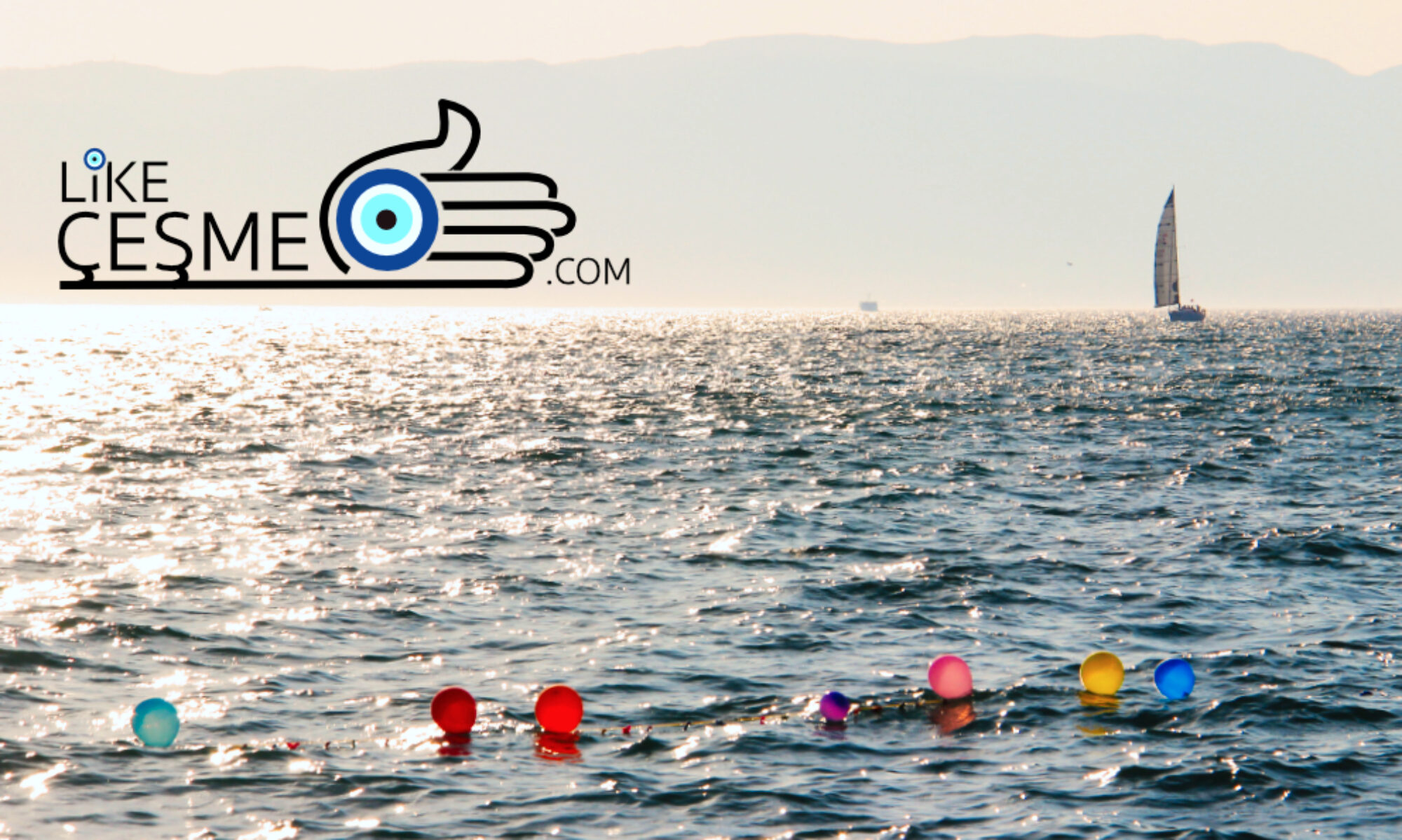The island of Chios is less commercialised than most other Greek islands and appeals to tourists looking for a more authentic and less crowded experience. Eco-tourism, cultural tourism, and culinary tourism are growing sectors. The island attracts visitors with its historical sites, secluded beaches, and unique cultural heritage. Key attractions include the medieval village of Pyrgi, the Nea Moni monastery (a UNESCO World Heritage site), and the mastic-producing villages.
Chios is the fifth-largest Greek island, covering an area of about 842 square kilometres in the northeastern Aegean Sea, close to Çeşme, separated by the Chios Strait. The island is predominantly mountainous, with its highest peak, Mount Pelineon, reaching about 1,297 metres. The landscape features rugged mountains, fertile plains, and numerous valleys. The southern part of the island is relatively flat and is known for its mastic tree plantations. Chios has a typical Mediterranean climate characterised by hot, dry summers and mild, wet winters. The island enjoys abundant sunshine throughout the year, making it ideal for agriculture, particularly olive groves, vineyards, and the famous mastic trees. Chios has a coastline of about 213 kilometres, featuring numerous beaches, coves, and small bays. The eastern coast is more developed, with the main port and town of Chios (Chora). The western coast is more rugged and less populated, with beautiful, secluded beaches.
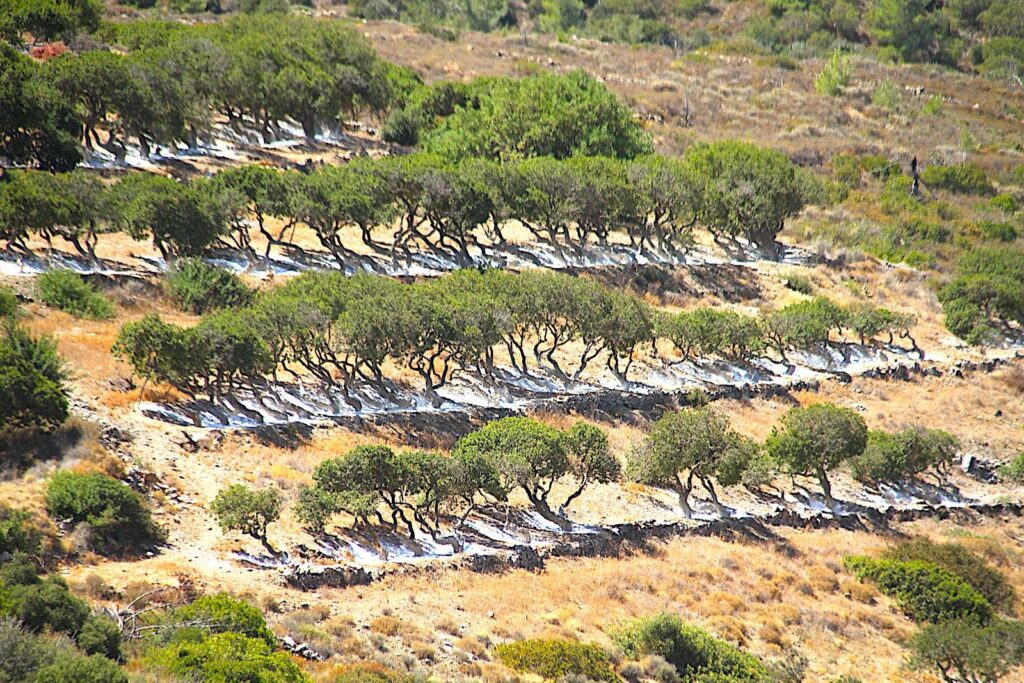
Chios – Table of Contents
Getting to Chios
From Çeşme Ulusoy Port, there are several daily sailing services to and from Chios (Sakız), and it is possible on Erturk Lines to take a day trip to the island, leaving in the morning and returning in the afternoon. It is advised to purchase tickets in advance either online or from the ferry lines ticket offices adjacent (south) to Çeşme Castle.
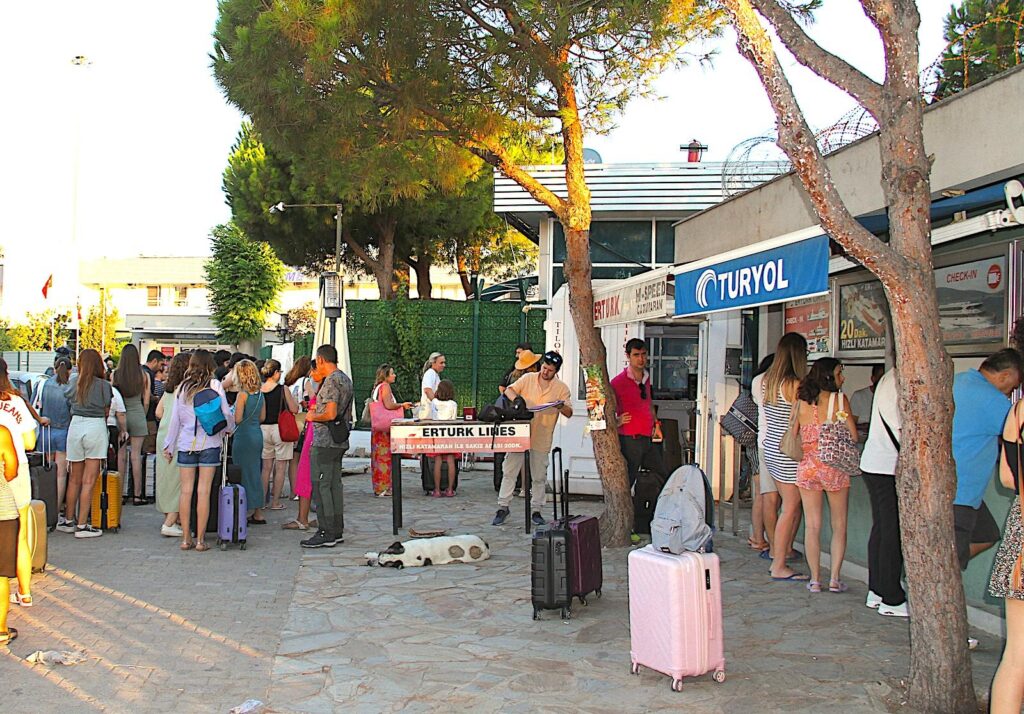
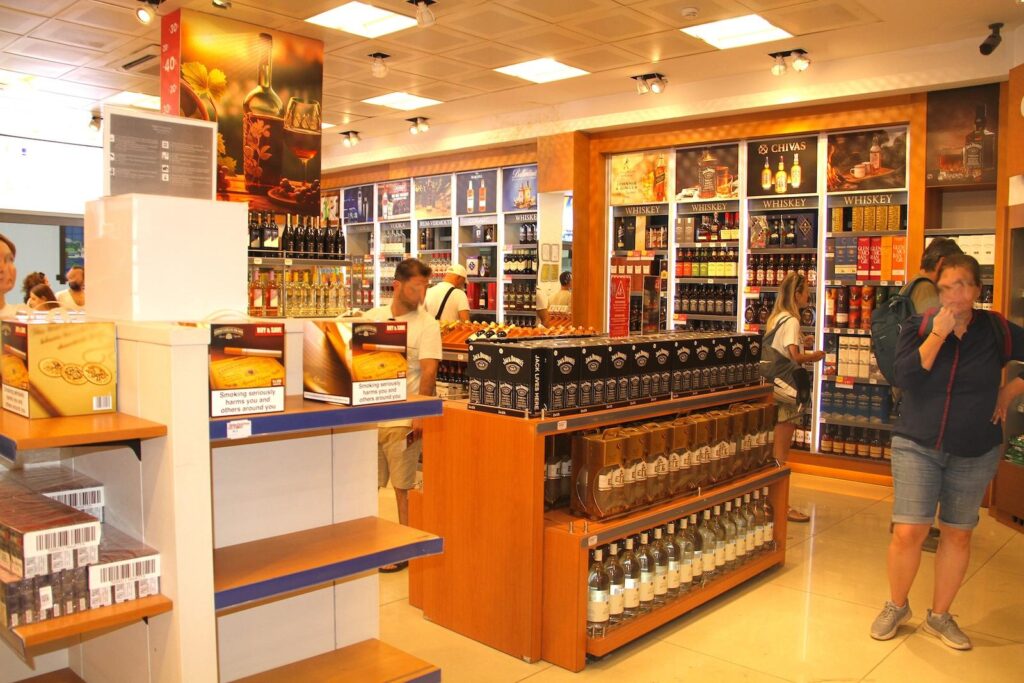


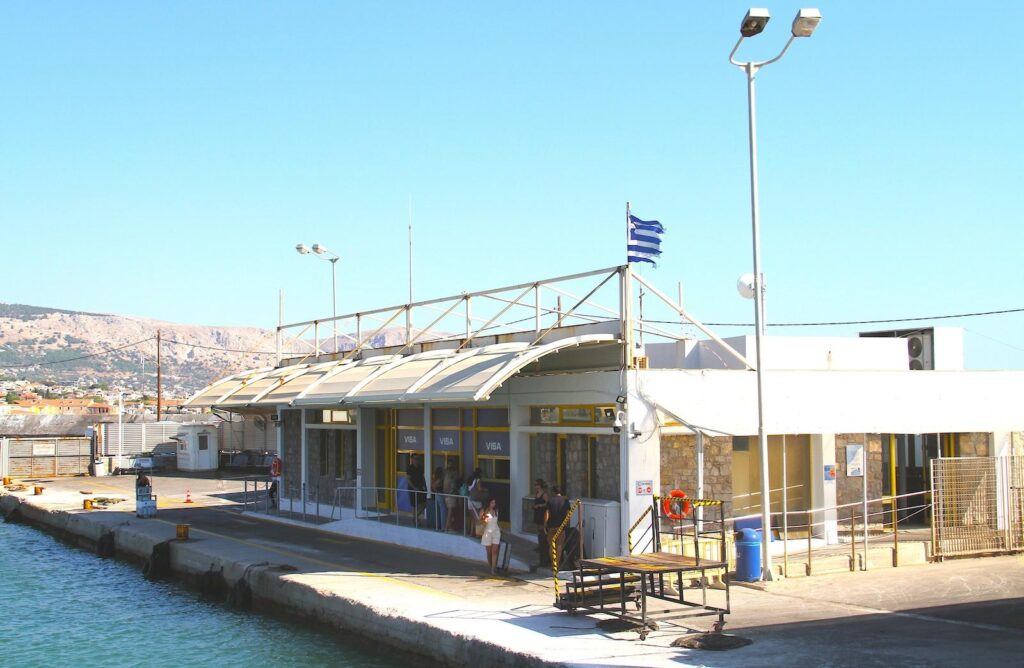
Duty-Free is available at Çeşme Ulusoy Port on departure and arrival, and there is also a café. Apart from passport and customs clearance, there are no services in the Chios Port Arrival Terminal.
See Likecesme.com: Ferry – Çeşme-Chios
Getting Around Chios
If you are considering venturing beyond the town of Chios then it would be advisable to hite a car. Driving around Chios by car is a delightful and scenic experience, offering the freedom to explore the island’s diverse landscapes, charming villages, and hidden gems at your own pace. The road network is well-maintained, with routes winding through lush valleys, olive groves, and mastic tree orchards, as well as along dramatic coastal cliffs with breathtaking views of the Aegean Sea. Highlights include the medieval mastic villages of Pyrgi and Mesta, the serene beaches of Karfas and Agia Dynami, and the historic Nea Moni Monastery.
While driving, you’ll encounter traditional Greek tavernas, local markets, and picturesque chapels, making it easy to stop and immerse yourself in the island’s culture. However, some rural roads can be narrow and winding, so cautious driving is recommended. A car is the best way to appreciate Chios’s natural beauty and rich heritage fully. Booking a vehicle well in advance is advisable as availability on the island is limited. During peak periods such as holidays and weekends, all rental companies can sell out of cars. Below is a quick link to the Chios page of Rentalcars.com:
Brief History of Chios
Chios has been inhabited since prehistoric times. In antiquity, it was known for its prosperous economy, primarily due to the production of mastic, a resin used in medicine, cosmetics, and culinary products. The island was a member of the Ionian League, and it became a significant maritime power. During the 5th century B.C., Chios allied with Athens during the Persian Wars (499-449 B.C.) and was later a member of the Delian League, though it revolted against Athens during the Peloponnesian War (431-405 B.C.). The island enjoyed a period of autonomy during the Hellenistic period, under the influence of various powers, including the Macedonians and later the Romans. Under Byzantine rule, Chios became an important administrative and ecclesiastical centre.
In 1346, the island came under the control of the Genoese, who managed it through the Maona company. The island’s economy flourished during this period, especially with mastic trade. Chios fell to the Ottomans in 1566, and the island became part of the Ottoman Empire. Although it retained some autonomy and continued to prosper due to the mastic trade, it suffered a significant blow during the Greek War of Independence in 1822 when the Ottomans massacred much of the population in retaliation for a rebellion. Chios was incorporated into the modern Greek state in 1912 during the First Balkan War. Since then, the island has been part of Greece, playing a role in both World Wars.
Chios Town
Chios Town, also known as Chora, is the capital and largest town on the island of Chios. It is the administrative, economic, and cultural centre of the island. Chios Town is on the island’s eastern coast, facing Çeşme, the town’s harbour, which has always been a key port in the Aegean Sea. The town combines modern and traditional elements, and the architecture in some parts reflects the influence of the Genoese and Ottomans, with narrow streets, arched passageways, and well-preserved mansions.
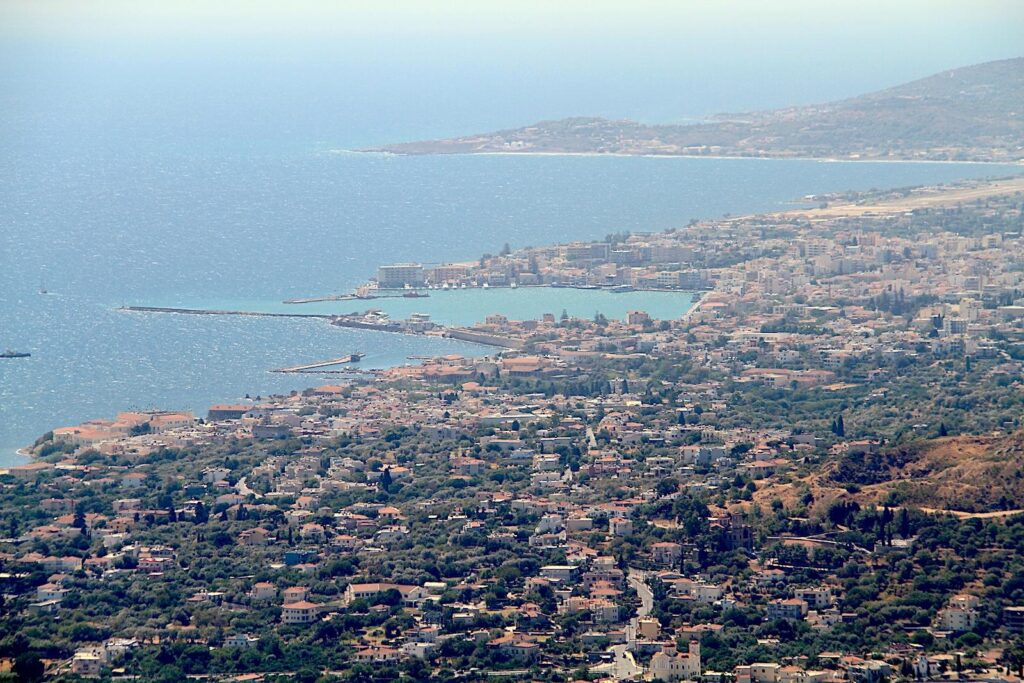
One of the most prominent landmarks is the Chios Castle (Kastro), a medieval fortress that dates to the Byzantine period but was significantly developed during the Genoese and Ottoman periods. The castle is located near the port and still contains houses and churches within its walls. The Ottoman Bath in the Castle of Chios is on the castle’s north side. The town is home to an archaeological museum that displays artefacts from various periods of the island’s history, including the prehistoric, classical, and Byzantine eras. Named after Adamantios Koraes, a prominent intellectual from Chios, the Koraes Library is one of the oldest in Greece and houses rare books, manuscripts, and historical documents. Reflecting the island’s long maritime tradition, the Chios Maritime Museum showcases the history of shipping and seafaring on Chios, with exhibits that include ship models, nautical instruments, and paintings.

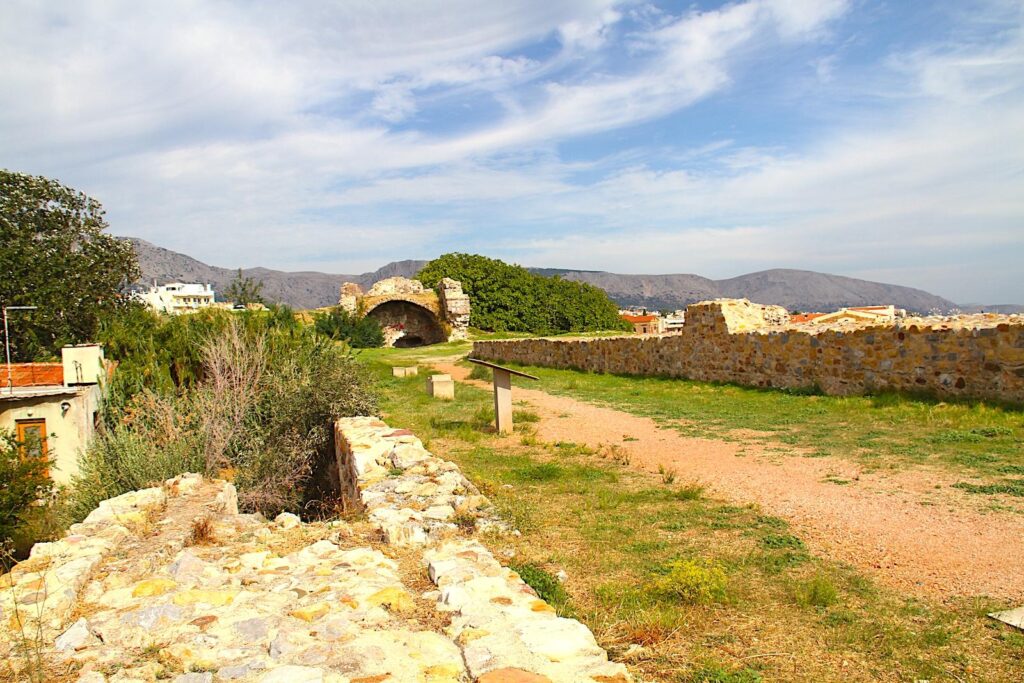
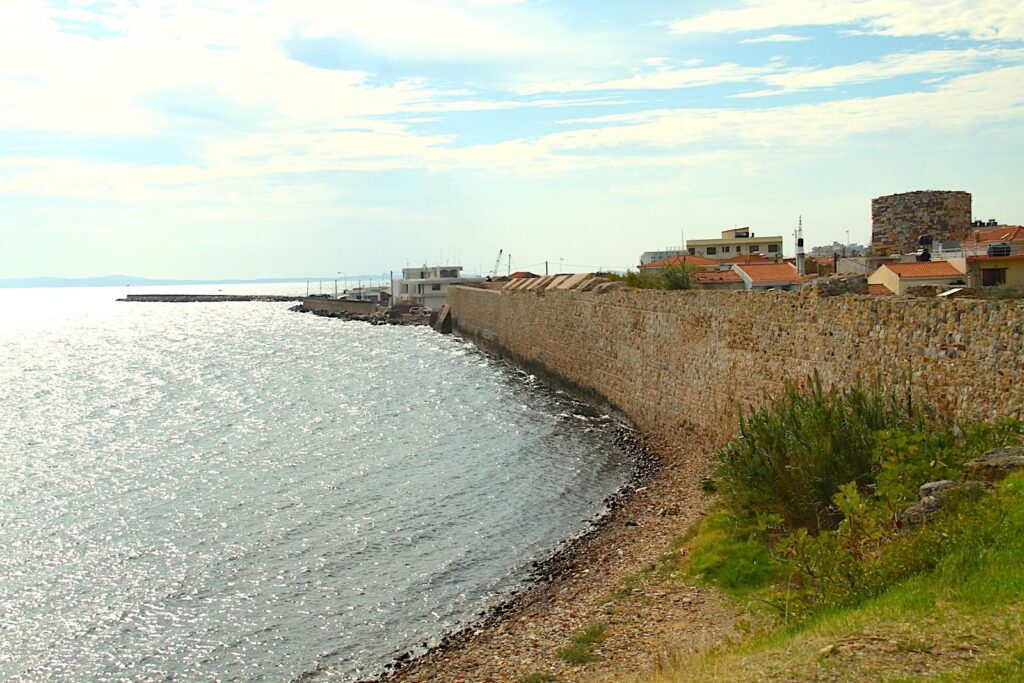
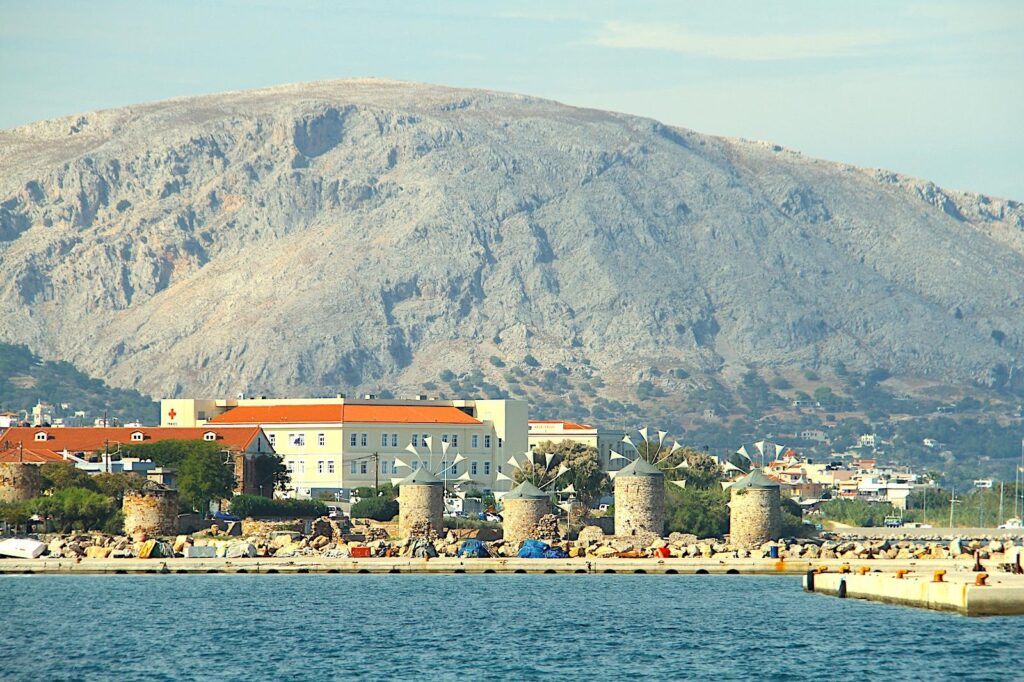
The port of Chios Town is a busy hub for commercial and passenger traffic, connecting the island with mainland Greece and other Aegean islands. It plays a crucial role in the local economy, facilitating trade, tourism, and transport. The town has a bustling market area with shops selling local products, such as mastic-based goods, olive oil, and textiles. Many cafes, tavernas, and restaurants offer traditional Chian cuisine. Located just a few kilometres south of the town centre, Chios Airport Omiros connects to Athens, other Greek cities, and some international destinations during the tourist season.

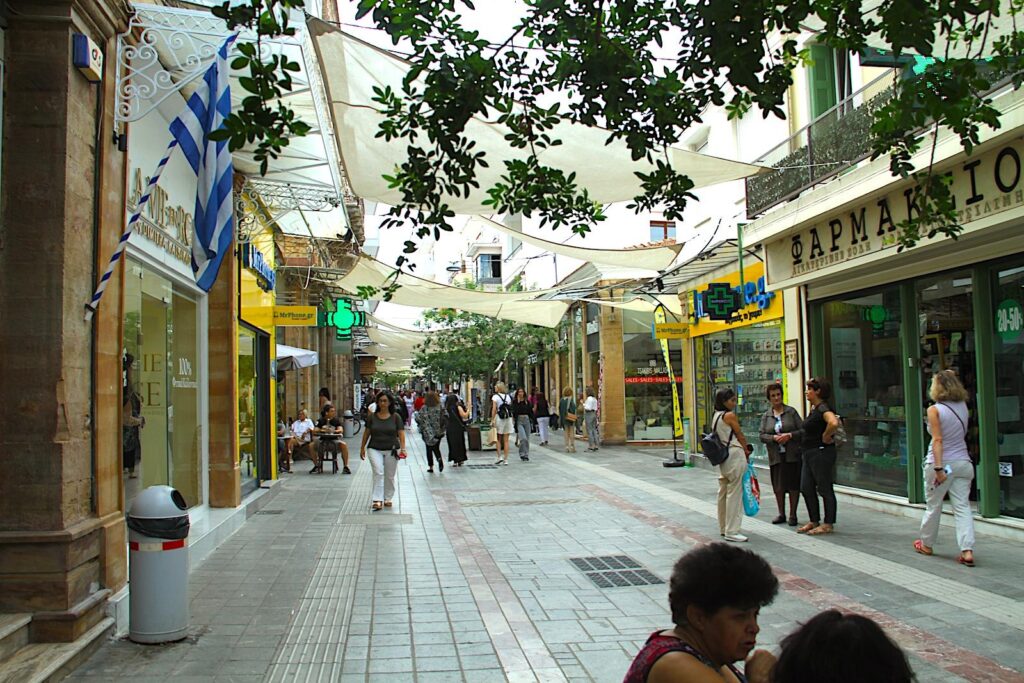


Chios Town is lively with cultural events, especially during the summer. Festivals celebrating music, traditional dance, and local cuisine are common. The town also observes religious festivals with processions and celebrations, reflecting the deep-rooted Orthodox Christian traditions of the island. The town offers a range of entertainment options, from quiet seaside cafes to vibrant bars and nightclubs. The waterfront promenade is a popular spot for evening strolls and socialising.
Chios Castle
Chios Castle, also known as “Kastro” in Greek, is a significant historical and architectural landmark in Chios Town. The origins of Chios Castle date back to the Byzantine period, likely around the 10th century, when it was first constructed as a fortification to protect the town and its inhabitants from pirate raids and other external threats. The castle was significantly expanded and fortified during the Genoese occupation of Chios, which began in 1346. The Genoese transformed it into a more substantial and elaborate fortress, adding defensive walls, towers, and other structures. This period marked the height of the castle’s importance as a military and administrative centre. Chios Castle came under Ottoman control in 1566, who made further modifications to the castle, adapting it to their needs and leaving a lasting imprint on its architecture. During this period, the castle housed military and civilian populations, including the local Ottoman governor and his administration. With the Ottoman Empire’s decline and Chios’s eventual integration into the modern Greek state in 1912, the castle’s military significance waned.
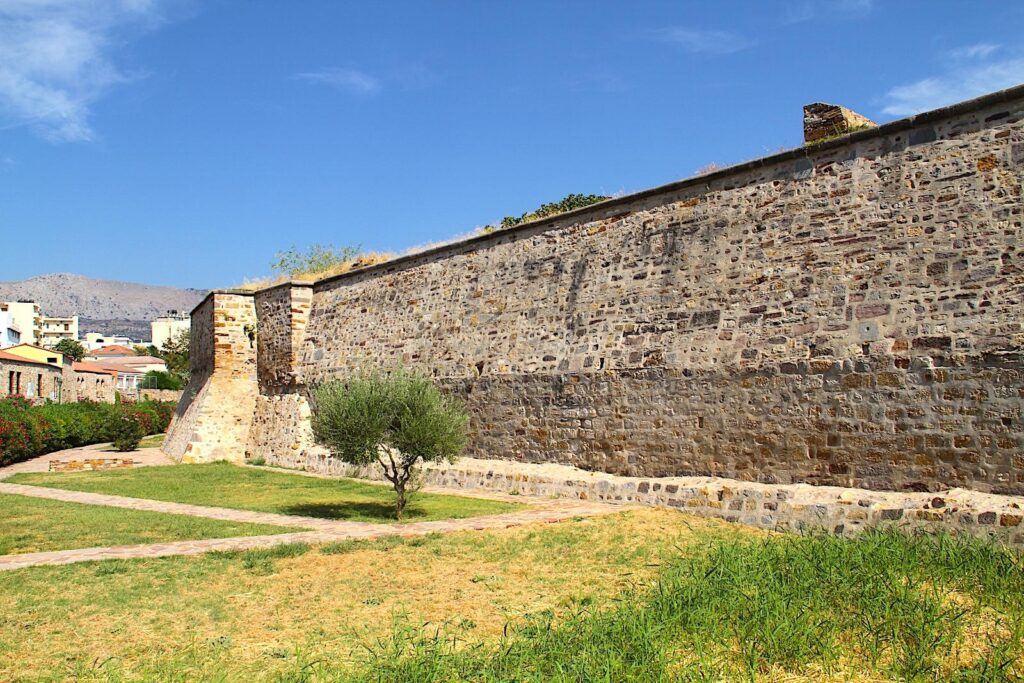

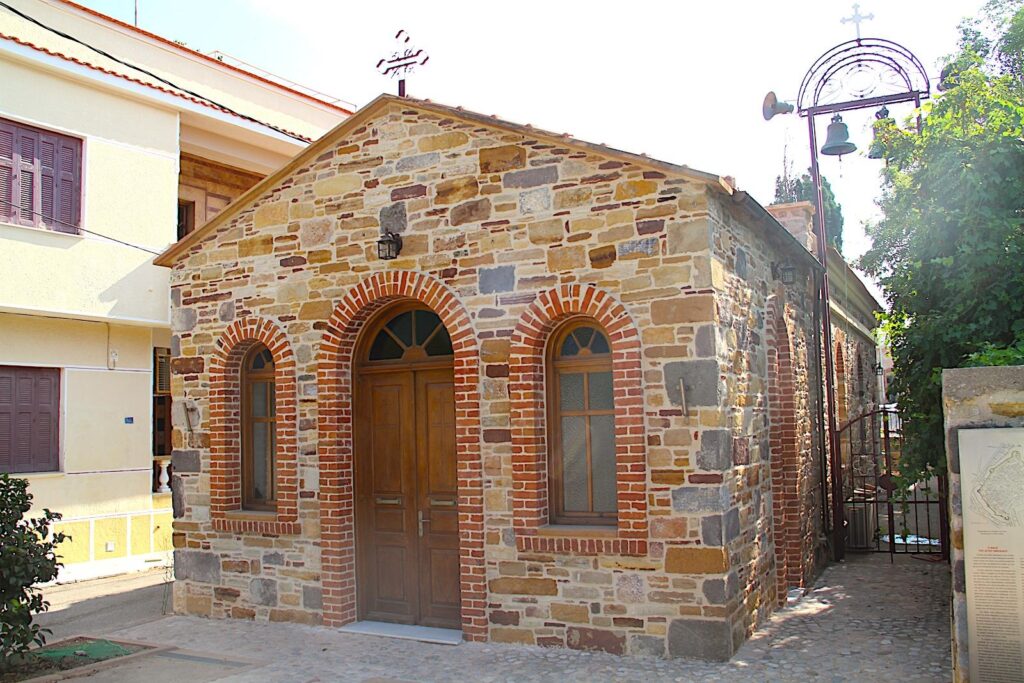
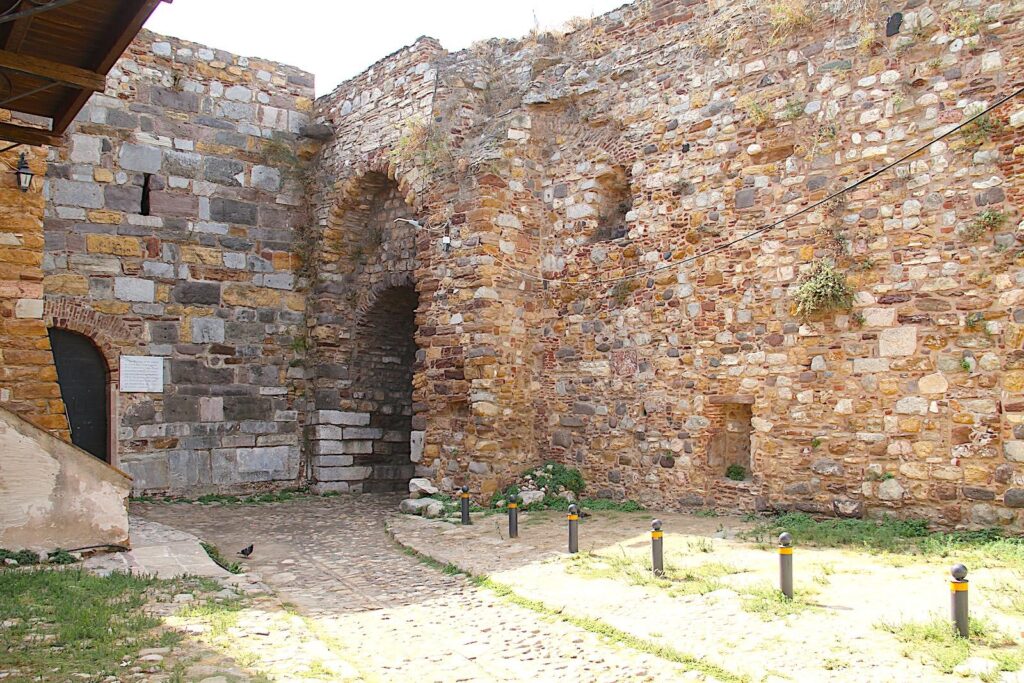
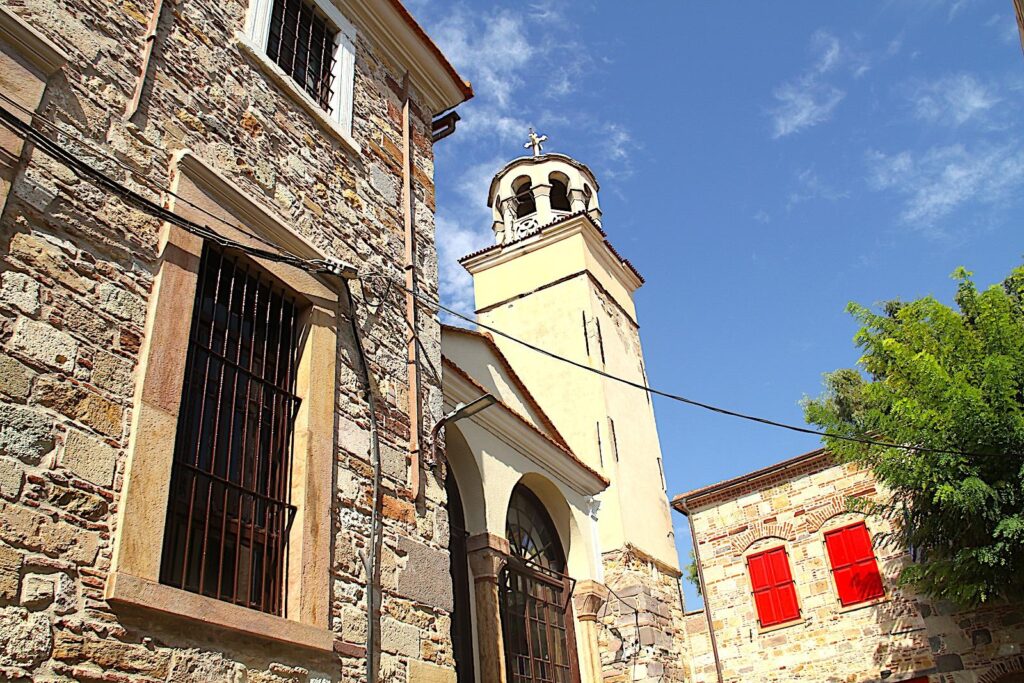
Chios Castle is surrounded by massive stone walls, roughly 1.8 kilometres in circumference. The walls are punctuated by several towers and bastions designed to provide defensive positions against invaders. The walls are particularly thick on the seaward side, reflecting the castle’s strategic location near the harbour. The castle has several gates, with the main entrance being the Porta Maggiore (also known as the Main Gate or Kastro Gate), which faces the town. This gate is a significant architectural feature, with towers flanking a large, arched entrance. The Porta Maggiore was initially equipped with a drawbridge over a moat. Within the castle walls lies the Acropolis, the central stronghold, which was the last line of defence in case of an attack. It includes several buildings, such as the governor’s residence, military barracks, and storage facilities. Uniquely, Chios Castle has long been a living community, with houses, narrow streets, and small squares inside the walls. Some homes are built directly into the fortifications, blending residential and defensive architecture. The area retains much of its medieval character, with many buildings reflecting Genoese and Ottoman architectural influences. Within the castle are remnants of Christian and Muslim religious structures. Notable among these is the Kale Mosque, which dates to the Ottoman period, and the Church of St. George, which served the Christian population living inside the castle.
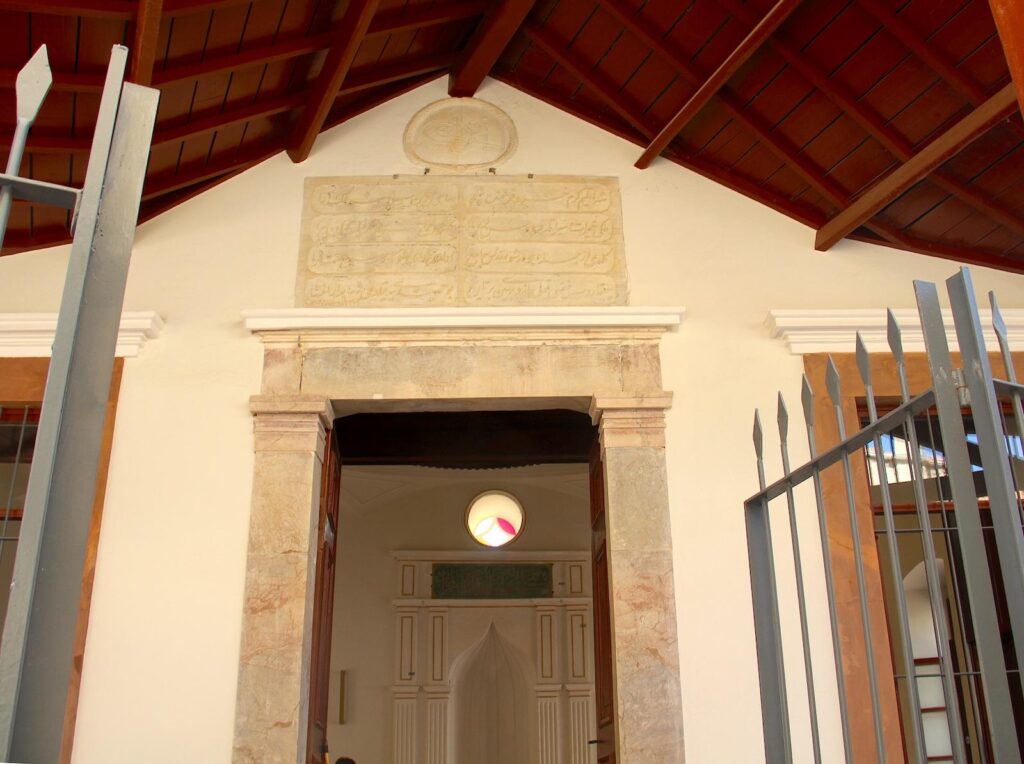
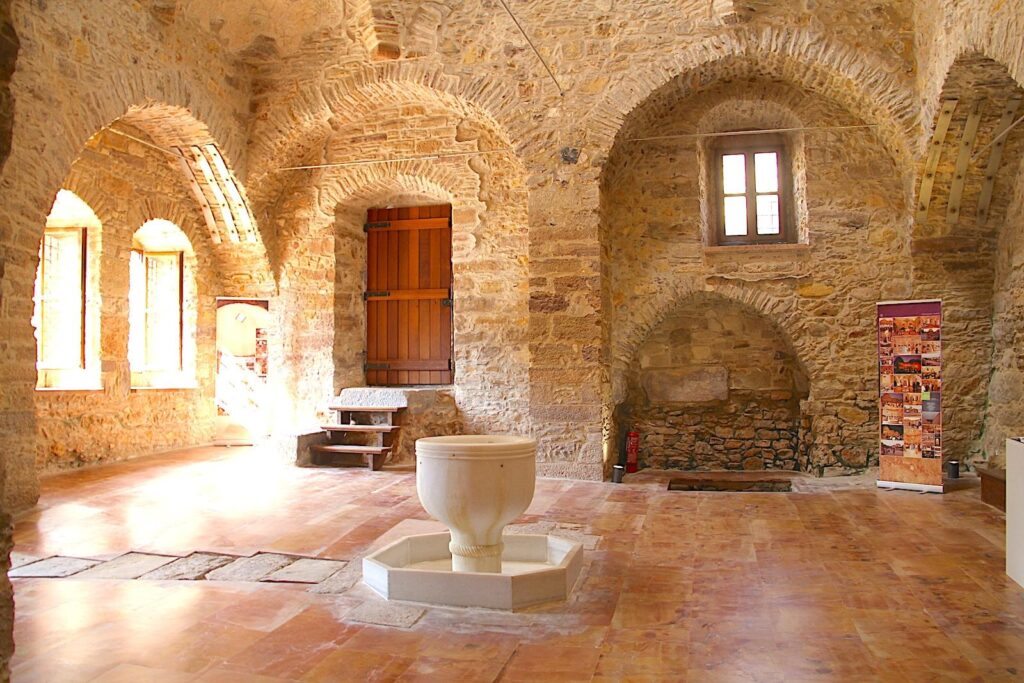
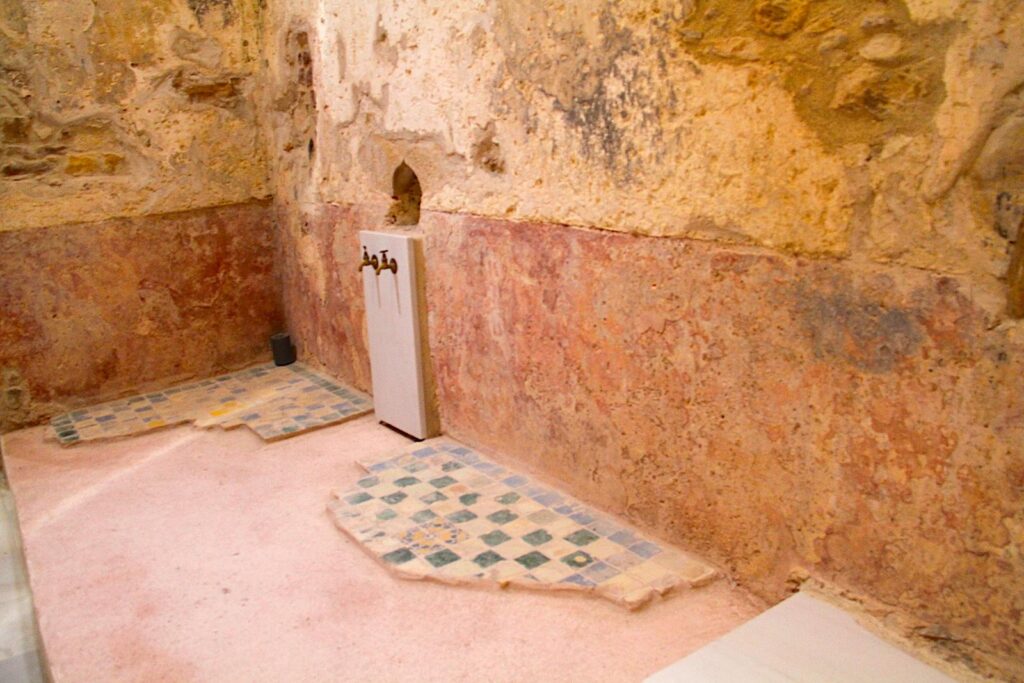
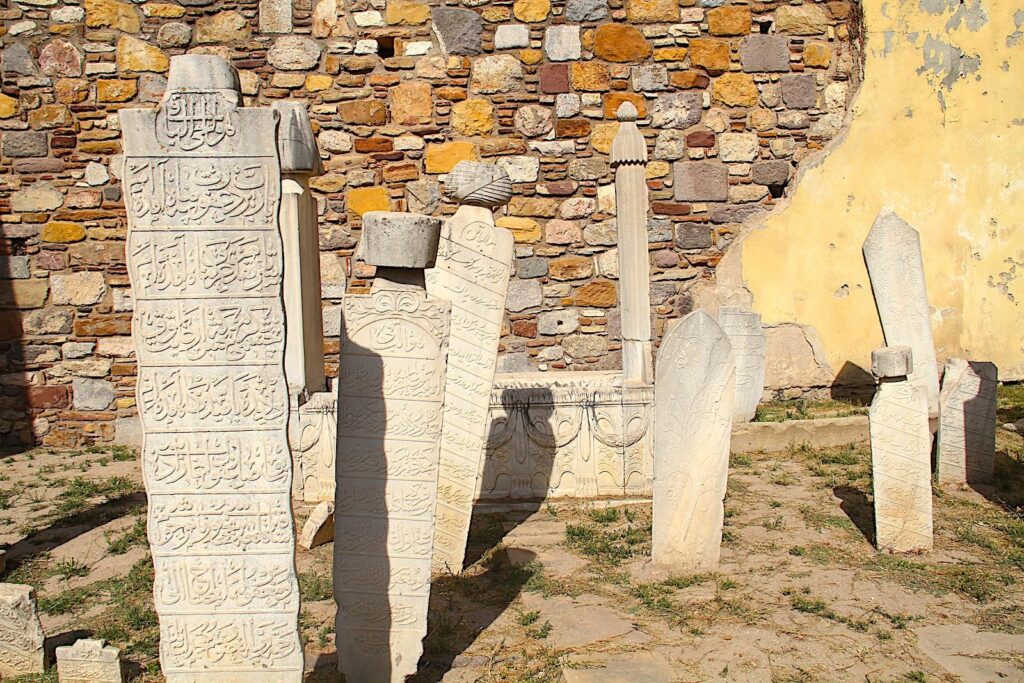

The Justinian Palace (Palazzo Giustiniani) is one of the most important buildings within the castle, believed to have been built during the Genoese period. It served as the residence of the local governor. The structure has been partially restored and is now used as a venue for cultural events and exhibitions. The Giali Tzamisi (Glass Mosque) is an Ottoman-era building near the castle’s main entrance. It is named after its once-prominent glass dome, damaged in an earthquake. The mosque now houses a small museum displaying archaeological finds from the castle area.
Byzantine Museum of Chios (Mecidiye Mosque)
Location: Chios 821 00, Greece – Open Wednesday-Monday 08:30-15:30
The Byzantine Museum of Chios showcases artefacts from the Byzantine period and offers insight into the island’s rich religious and cultural history. The building that now houses the Byzantine Museum was initially constructed as the Mecidiye Mosque during the Ottoman period and was named after Sultan Abdülmecid I, who ruled the Ottoman Empire from 1839 to 1861. The mosque was no longer used for religious purposes after the island was integrated into the modern Greek state in 1912. The building was repurposed as the Byzantine Museum of Chios in the following years, preserving its architectural integrity while adapting it to a new role as a cultural institution. Inside, the museum retains the open, spacious layout of the mosque, with the former prayer hall now serving as the main exhibition space. The museum’s collection focuses on the Byzantine period, from the 4th to 15th centuries A.D., including various religious artefacts, icons, frescoes, and ecclesiastical objects. The museum houses a significant collection of Byzantine icons notable for their intricate detail and spiritual significance. The collection also includes fragments of frescoes from Byzantine churches on the island. The museum displays various ecclesiastical items, including crosses, chalices, vestments, and manuscripts. The collection also features Byzantine-era sculptures and reliefs, many of which were initially part of churches and other religious buildings on the island.

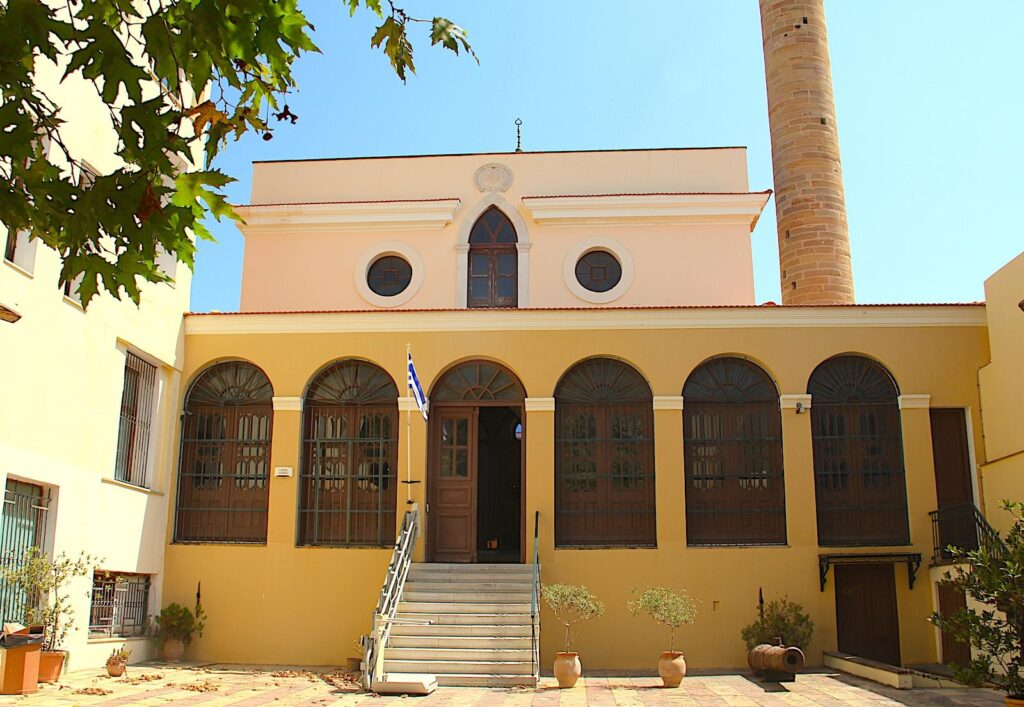
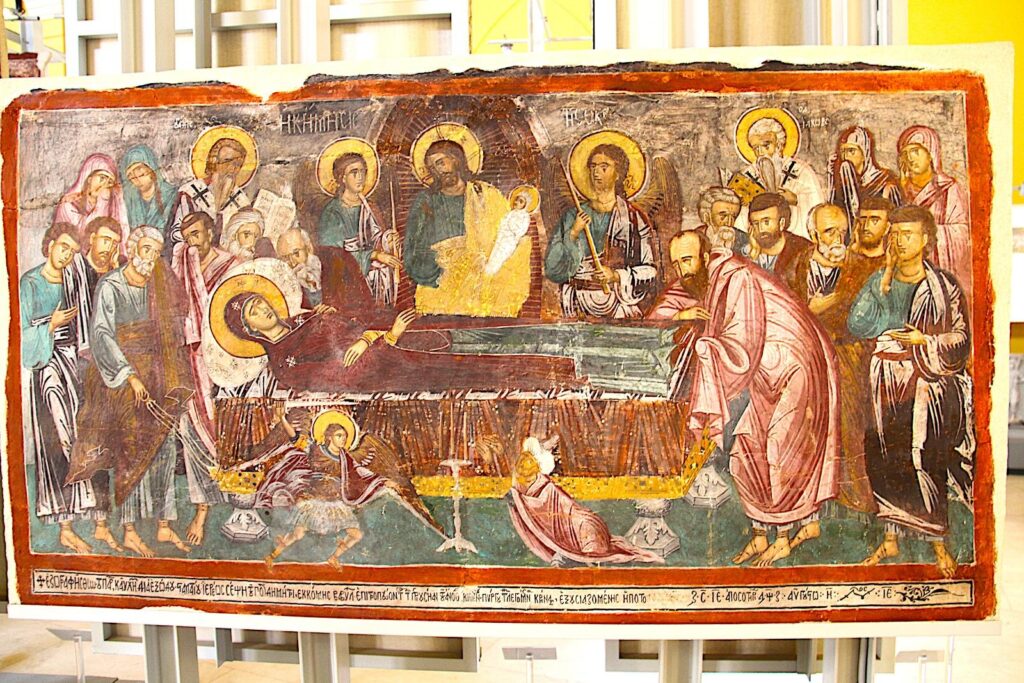
Archaeological Museum of Chios
Location: Michalon 10, Chios 821 00, Greece – Temporarily closed (as of August 2024)
The Archaeological Museum of Chios was established in 1965 to preserve and display archaeological finds from various excavations on the island. It is a repository for artefacts illustrating Chios’s long and varied history. The museum is housed in a modern building designed specifically to accommodate an archaeological collection, with spacious galleries that allow for the proper display and preservation of the artefacts.
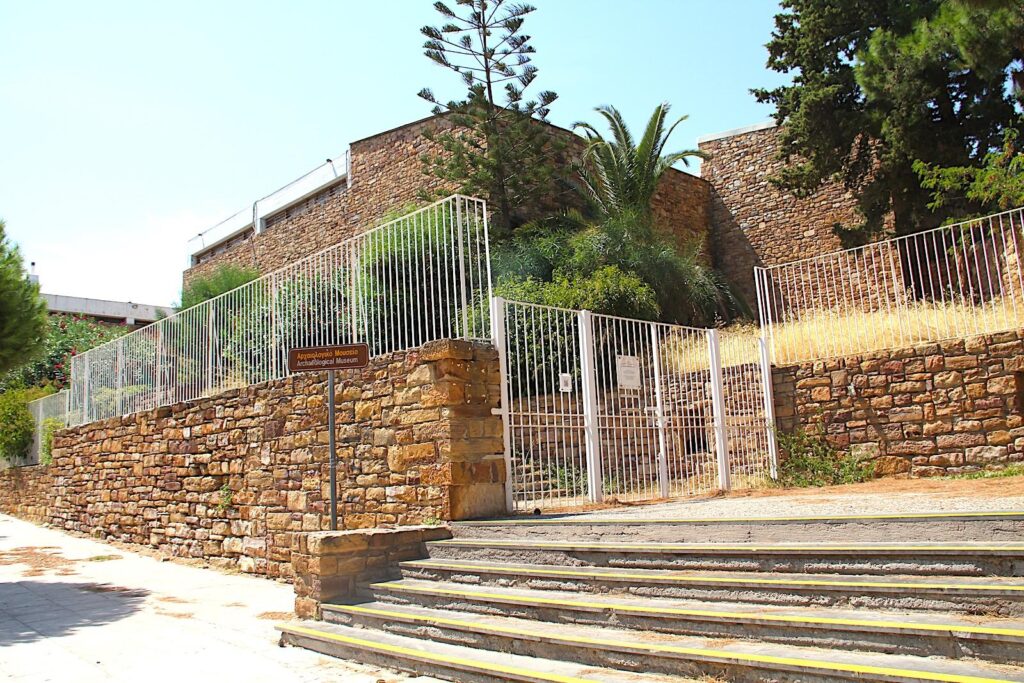
The collection includes pottery, tools, and other artefacts from the Neolithic and Early Bronze Age, offering insights into the earliest human settlements on the island. Artefacts from prehistoric settlements such as Emporio and Agios Galas, including pottery, figurines, and tools, are on display. The museum houses a significant collection of Mycenaean artefacts, including pottery, weapons, and jewellery from the Late Bronze Age. One of the highlights is a reconstruction of a Mycenaean tholos tomb, a beehive-shaped burial structure. The museum’s collection from the Geometric and Archaic periods includes pottery with intricate geometric patterns, terracotta figurines, and sculptures and reliefs from this period. The museum has a range of classical and Hellenistic sculptures, including statues and busts of gods, goddesses, and notable figures. A significant collection of ancient coins and inscriptions from the Classical and Hellenistic periods provides insights into Chios’s economic and political history. The museum’s Roman collection includes pottery, mosaics, and everyday objects that highlight the continued importance of Chios during the Roman era.
Chios Maritime Museum
Location: 20, St Tsouri Street, Chios City 821 00, Greece – Chios Maritime Museum English Website – Open Monday-Saturday 09:00-14:00 – Entrance €3.00 as of August 2024.
The Chios Maritime Museum was established in 1991 by the Chios Shipping Companies’ Association. The goal was to create a space dedicated to preserving and showcasing the island’s maritime history, reflecting its significant role in global shipping. The museum is housed in a neoclassical mansion once the home of a prominent shipping family in Chios. The museum features a collection of meticulously crafted ship models representing different types of vessels used by Chian sailors over the centuries. These include models of ancient triremes, Byzantine dromons, Ottoman-era ships, 19th and 20th-century sailing ships, and steamers. There are also models of modern cargo ships and tankers, reflecting Chios’ ongoing importance in the global shipping industry. The museum’s collection includes a variety of nautical instruments such as compasses, sextants, chronometers, and maps. These tools were essential for navigation and are displayed alongside explanations of how sailors used them. Visitors can also see various pieces of maritime equipment, including anchors, ship bells, and life-saving devices, providing insight into the daily life of seafarers.
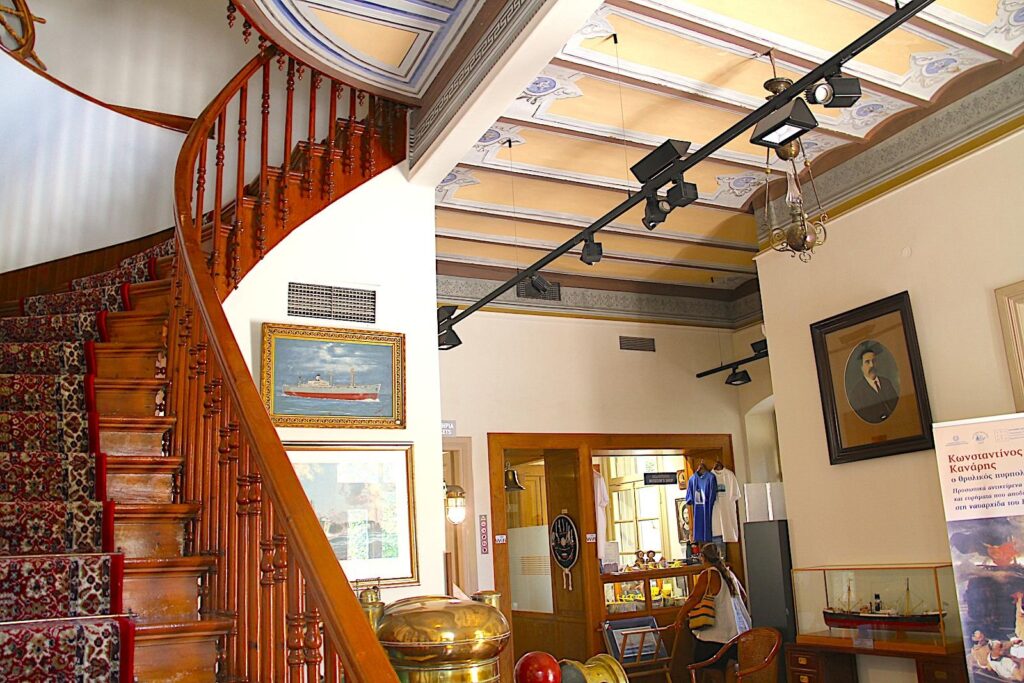
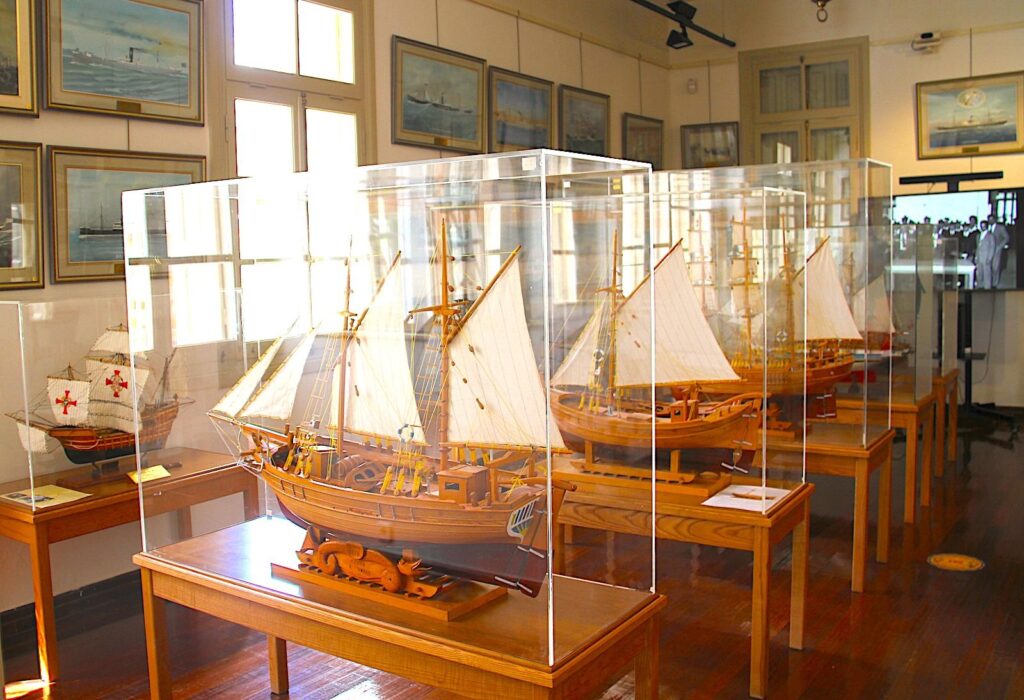

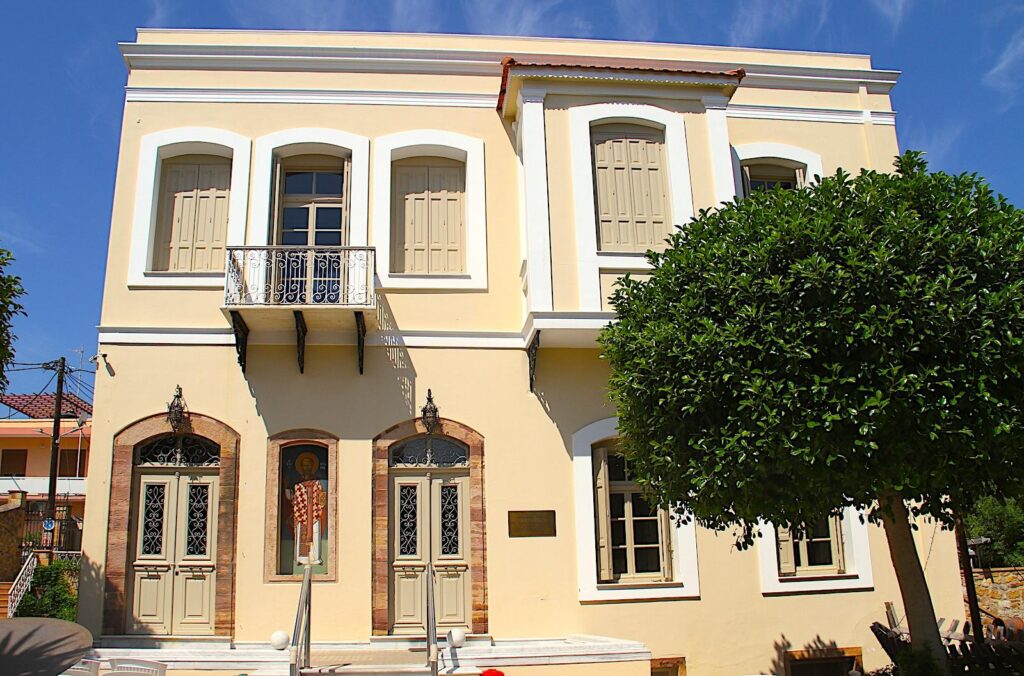
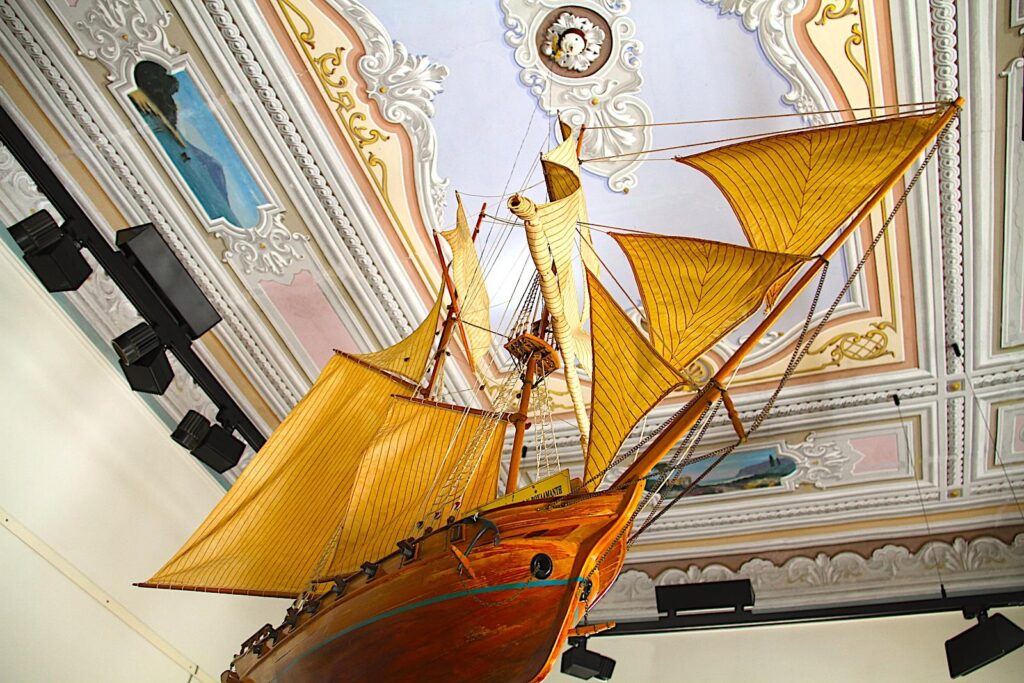
The museum has an impressive collection of maritime-themed paintings, many depicting famous ships, seascapes, and naval battles. The museum also features portraits of notable Chian shipowners, captains, and sailors who played significant roles in the island’s maritime legacy. The museum houses a collection of shipping records, including ship logs, contracts, and letters, which provide a detailed account of Chios’ naval activities over the centuries. A vast archive of photographs documents the evolution of Chios’ maritime industry, capturing everything from traditional wooden shipyards to modern shipbuilding techniques. The exhibits trace the island’s maritime history from ancient times to today, illustrating how Chios developed into one of Greece’s most important shipping centres. A significant focus is placed on the history of merchant shipping, which has been a cornerstone of Chios’ economy for centuries. The museum details the rise of prominent shipping families from Chios and their contributions to global trade.
Homerion Cultural Centre
Location: Polytechneiou 5, Chios 821 00, Greece – Homerion Cultural Centre English Website (includes calendar of events)
The Homerion Cultural Centre promotes the island’s arts, education, and cultural activities. Named after Homer, the legendary epic poet traditionally associated with Chios, the centre is a hub for cultural exchange and community engagement. The centre was established in 1980 by the Municipality of Chios. It was created to foster cultural development on the island and provide a space for artistic and educational activities. The Homerion Cultural Centre is housed in a modern building that accommodates various cultural and creative activities. The building includes several multi-purpose spaces, such as auditoriums, exhibition halls, and conference rooms. These spaces are designed to be flexible, allowing them to be used for different types of events, from concerts and theatre performances to art exhibitions and educational workshops.
Vounaki Square & Public Gardens
Location: Chios 821 00, Greece
The main square in Chios Town, Vounaki Square, is a vibrant area surrounded by cafes, shops, and historical buildings. It’s a popular gathering spot for locals and tourists and often hosts public events, festivals, and markets. The square is also home to the statue of Constantine Kanaris, a hero of the Greek War of Independence. Adjacent to the square are the Public Gardens of Chios, which offer a peaceful retreat in the town. The landscaped gardens include a variety of trees, plants, and flowers, as well as statues and monuments that reflect the island’s cultural and historical heritage.
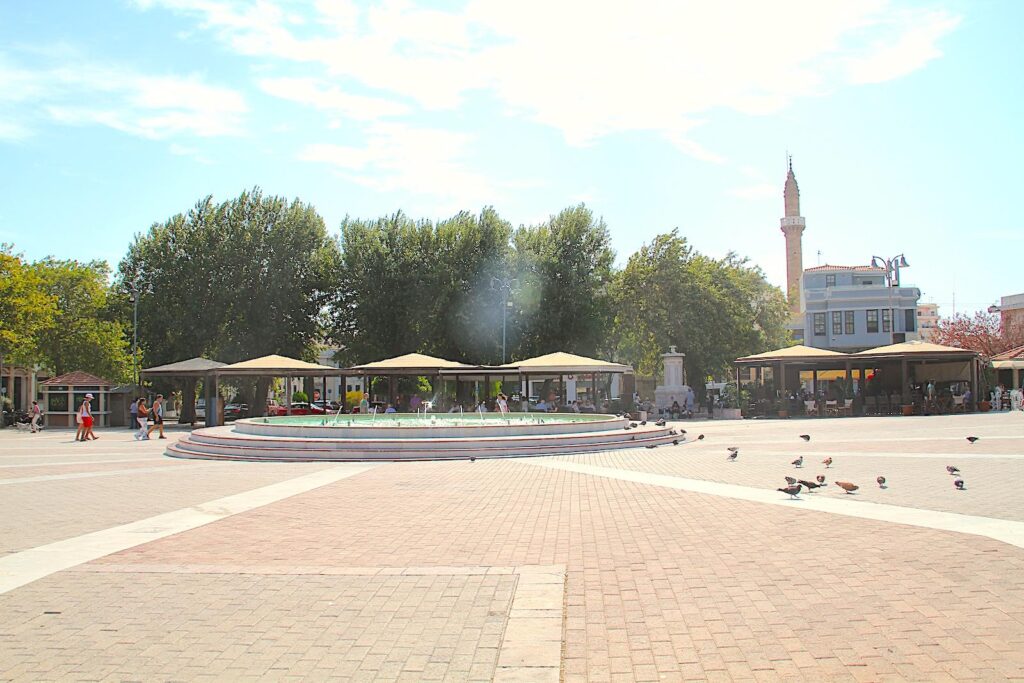

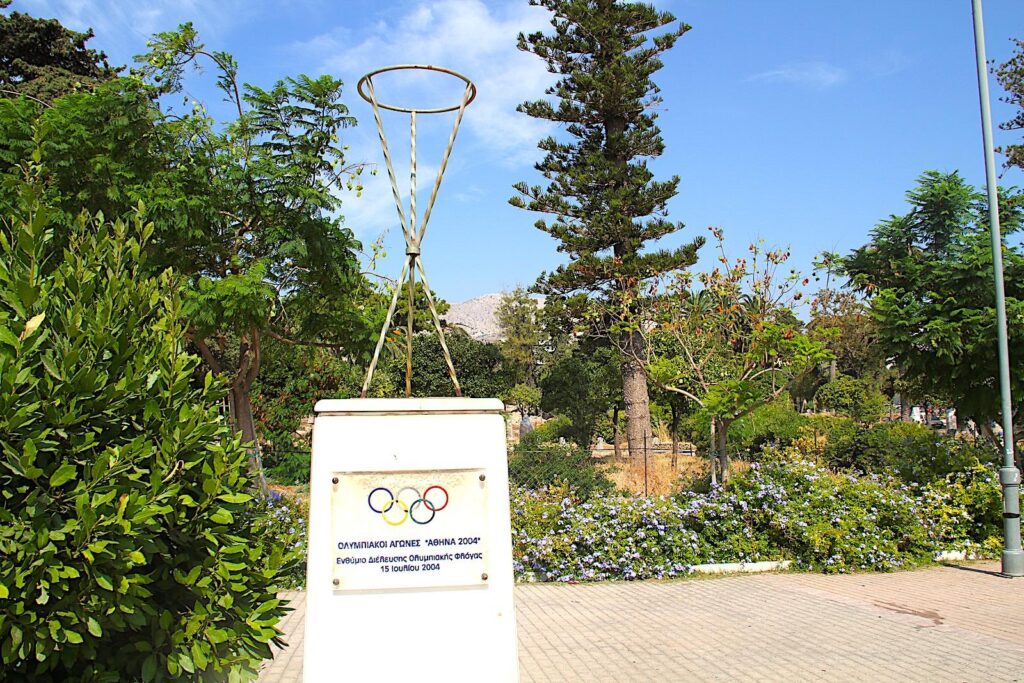
Beyond Chios Town
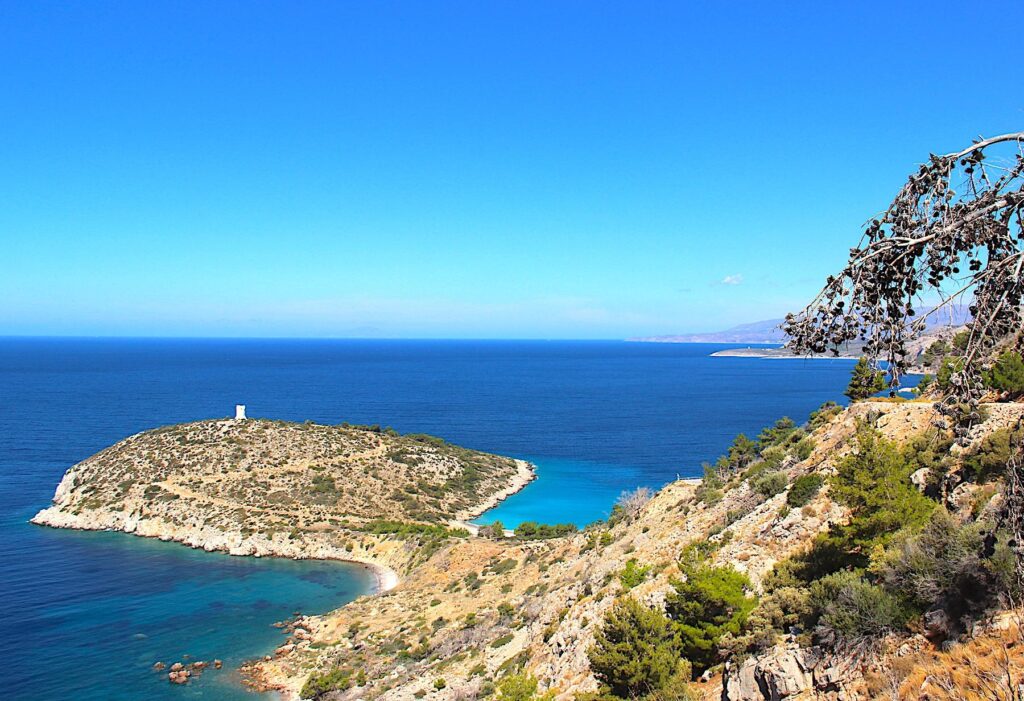
Nea Moni Monastery
Location: Nea Moni of Chios 821 00, Greece (12km west of Chios Town in the centre of the Island) – Open daily 08:00-13:00 + 17:00-19:00
The Nea Moni Monastery is one of the most significant Byzantine monuments in Greece, renowned for its stunning mosaics and rich history; the monastery is a UNESCO World Heritage Site and a testament to the religious and artistic heritage of the Byzantine Empire. The Nea Moni Monastery was founded in the mid-11th century by Byzantine Emperor Constantine IX Monomachos and his wife, Empress Zoe. According to tradition, the emperor funded the monastery’s construction after being restored to the throne, fulfilling his vow while in exile. The construction of the monastery began around 1042 and was completed by 1055. It was built on the site where three monks, Niketas, Ioannes, and Joseph, claimed to have discovered a miraculous icon of the Virgin Mary, which was believed to have contributed to Constantine’s return to power.
The central church, or katholikon, is the most important building within the monastery and is an exemplary representation of the octagonal cross-in-square design, a common architectural style in Byzantine churches. The church features a large dome supported by eight arches, creating a spacious and harmonious interior. The interior of the katholikon is adorned with mosaics, considered among the finest examples of Byzantine art, depicting various religious scenes, including the Dormition of the Virgin Mary, Christ Pantocrator, and the Annunciation. The monastery complex also includes the refectory, the cistern, and the monks’ cells. The refectory, where the monks would gather for meals, is a long, narrow hall with a vaulted ceiling.
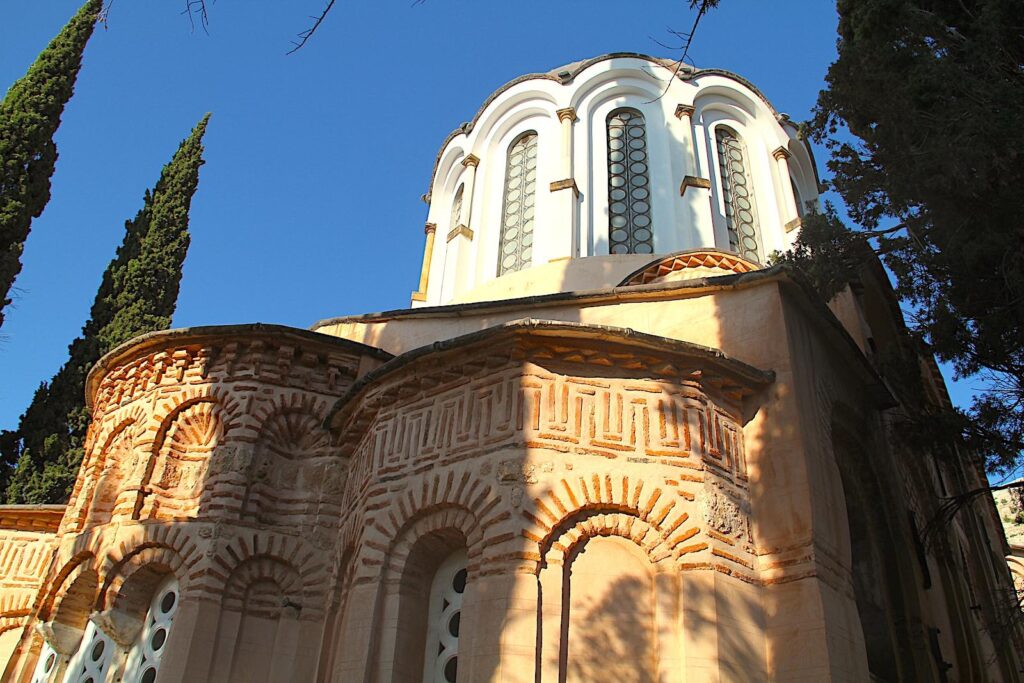
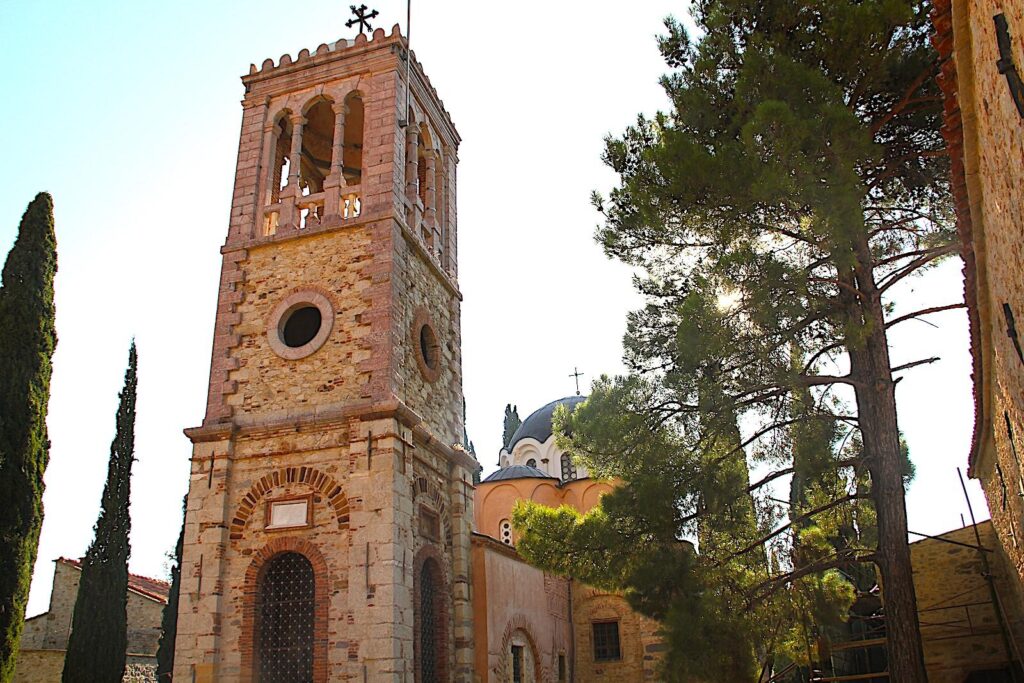
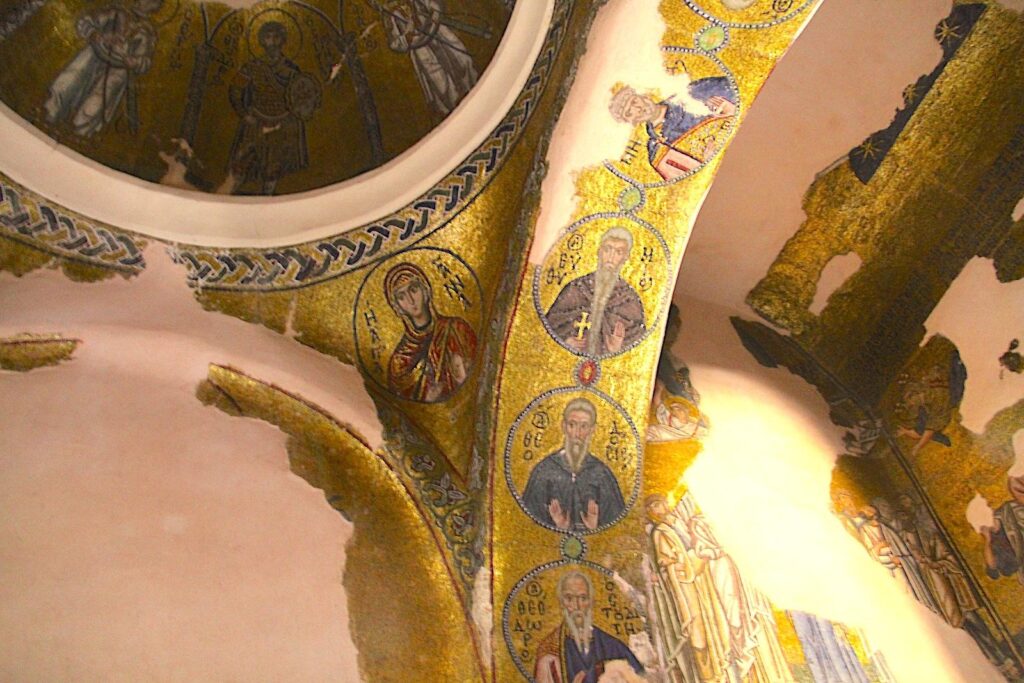
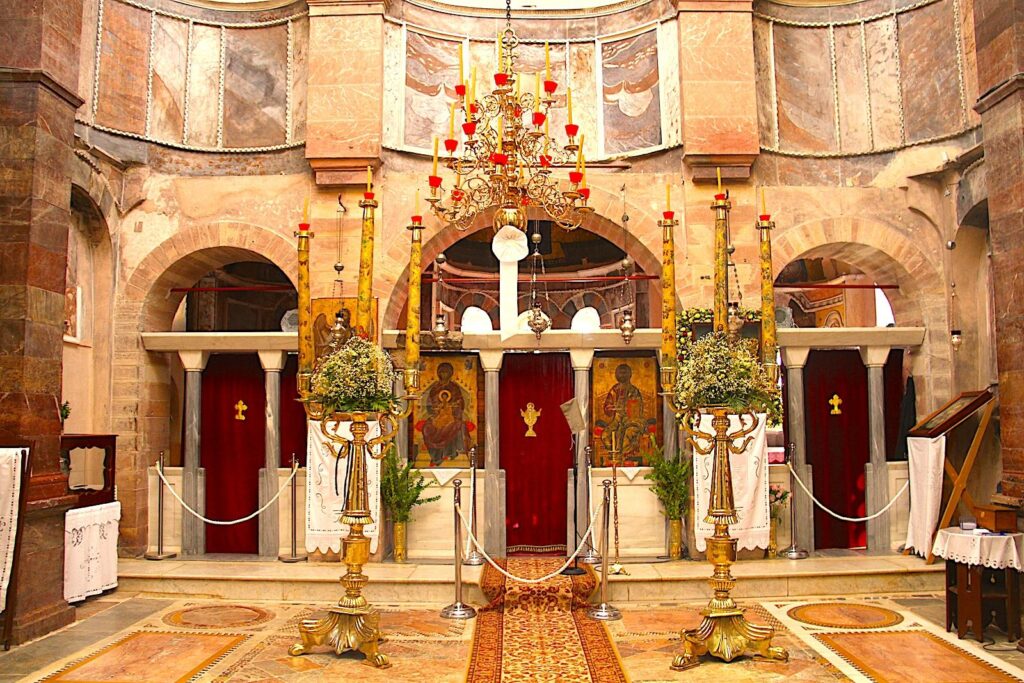

Nea Moni Monastery was a major spiritual centre in the Byzantine Empire and became an important religious site throughout the centuries. It was a place of pilgrimage, attracting visitors who came to venerate the miraculous icon of the Virgin Mary and to see the renowned mosaics. During the Ottoman occupation of Chios, the monastery suffered from several destructive events. It was partially damaged in the 1822 massacre of Chios when the Ottoman forces retaliated against the Greek War of Independence. The monks were killed, and many of the buildings were destroyed or heavily damaged. In 1881, a devastating earthquake further damaged the monastery, including parts of the katholikon and some mosaics. The 20th century saw significant restoration efforts to preserve the remaining structures and mosaics. These efforts have helped protect the monastery’s historical and artistic heritage, allowing it to continue to be appreciated by visitors today. In 1990, Nea Moni was designated a UNESCO World Heritage Site to recognise its cultural and historical importance.
Part of the monastery has been converted into a museum, where visitors can learn about its history and view artefacts related to the monastic life. Although the monastic community is smaller today, the monks who reside there continue the traditions of prayer and worship, maintaining the spiritual essence of the monastery. Nea Moni is situated on the slopes of Mount Provateio Oros, approximately 12km west of Chios Town; it offers stunning views of the surrounding landscape, adding to the serene and contemplative atmosphere of the monastery.
Sanctuary of Cybele at Daskalopetra (Homer’s Rock)
Location: Ιερό Κυβέλης στη Δασκαλόπετρα (Πέτρα του Ομήρου) – Omiroupoli 822 00, Greece. Close to Vrontados, 6km north of Chios Town
The Sanctuary of Cybele at Daskalopetra is an ancient religious site near Vrontados. This site is dedicated to Cybele, the ancient Phrygian mother goddess, who was worshipped as a symbol of fertility and nature. The sanctuary dates back to the 6th century B.C. and is one of the oldest religious sites in Chios. Originally a Phrygian deity, Cybele was later adopted by the Greeks and Romans, who associated her with the Earth and nature. The most prominent feature of the sanctuary is the rock-cut altar, where offerings were likely made to the goddess. The altar is carved directly into the natural rock, facing the sea, and was probably used for ritual ceremonies. Though not much remains today, traces of ancient inscriptions and relief carvings dedicated to Cybele can be found at the site. The site is also closely associated with local legends related to the poet Homer. According to tradition, the rock at Daskalopetra, often called “Homer’s Rock,” is where Homer is said to have sat and taught his students.
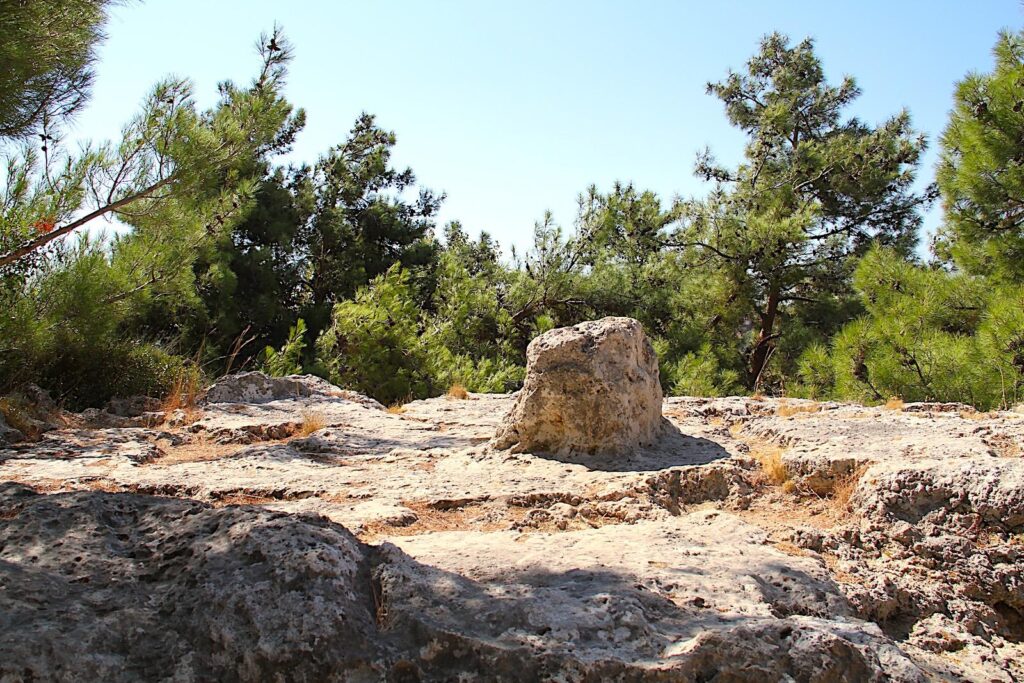
Heroes’ Monument Chios
Location: Epar. Od. Chiou-Keramou, Chios 822 00, Greece: 10km north of Chios Town
The Heroes’ Monument on the Chiou-Keramou road in Chios is a striking memorial dedicated to the memory of the Chians who fought and perished during the battle with the Ottomans on Epos Hill on 15 November 1912. This monument stands along a key route between Chios Town and the northern village of Keramos. Nearby is the tomb of author Ioannis Psycharis (1854-1929), a significant promoter of the Demotic Greek language. Set against a backdrop of rugged hills, the memorial is an imposing structure featuring a marble column on a stone base. It is accompanied by plaques that commemorate the fallen soldiers who sacrificed their lives during the Axis occupation of Greece. The surrounding area offers stunning views across the island’s east down to Chios Town and across to Çeşme and Karaburan. It has a tranquil and reflective atmosphere, with the natural beauty of Chios Island’s countryside enhancing the solemnity of the site. There is a small, unsurfaced rough track down to the site about 20 metres from a sharp bend off the main road.
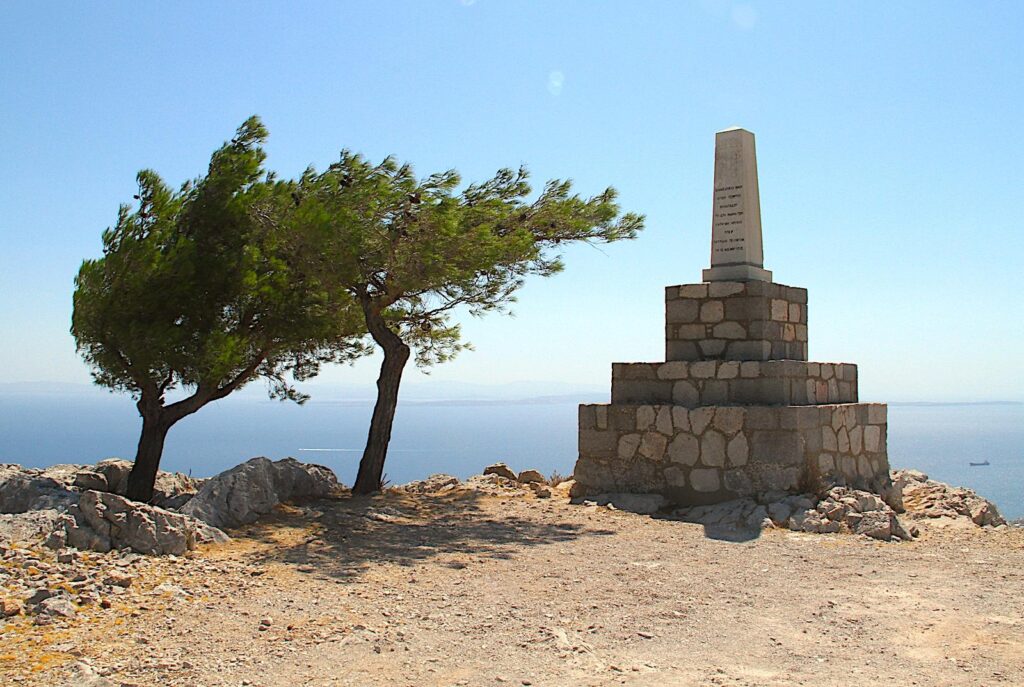
The Castle of Volissos
Location: The Castle of Volissos (Κάστρο της Βολισσού), Amani 821 03, Greece. 40km northwest of Chios Town.
The Castle of Volissos is a prominent medieval fortress on a hill overlooking the village of Volissos in northwestern Chios. This historic castle is one of the island’s most significant landmarks and is believed to have been originally constructed during the Byzantine period, likely in the 11th century. Its location was chosen for its strategic vantage point, providing expansive views of the surrounding area and the Aegean Sea. The Genoese further fortified the castle from the 14th to the 16th century, expanding and strengthening the castle as part of their defence network across the island. The elevation provides panoramic views, allowing for early detection of approaching enemies, particularly pirates, who were a common threat in the medieval Aegean. The castle’s design is relatively simple, with a rectangular layout typical of many medieval fortresses, practical, focusing on defence and the ability to house a garrison. The castle features six circular towers at various points along its walls. Today, the Castle of Volissos is mostly in ruins, but significant portions of the walls and towers remain intact. Some efforts have been made to preserve and restore parts of the castle, although it remains largely ruined.
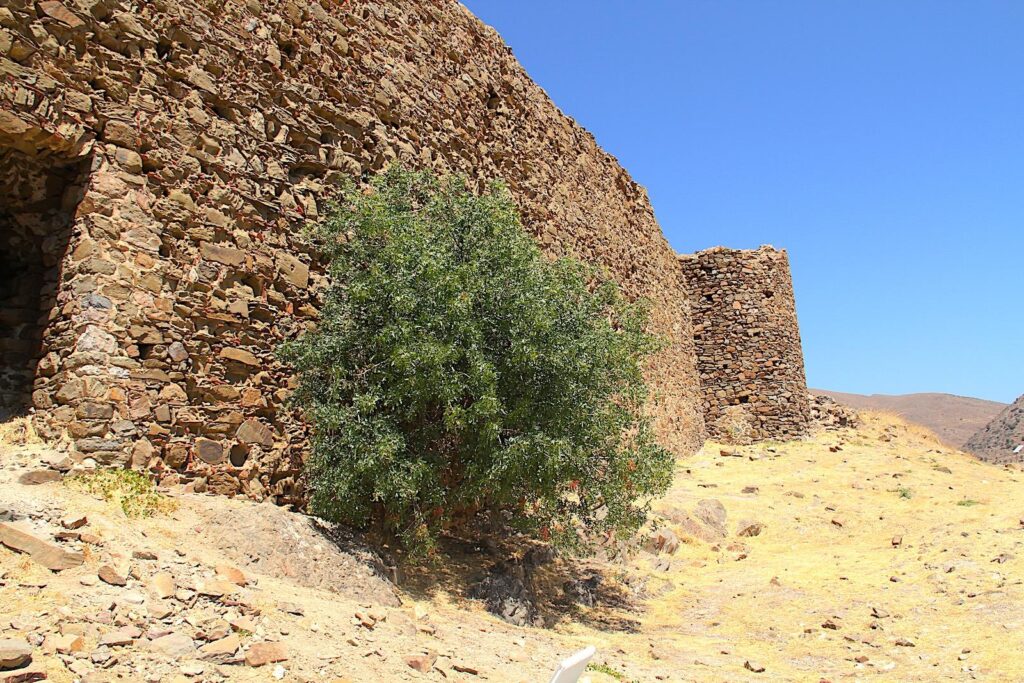
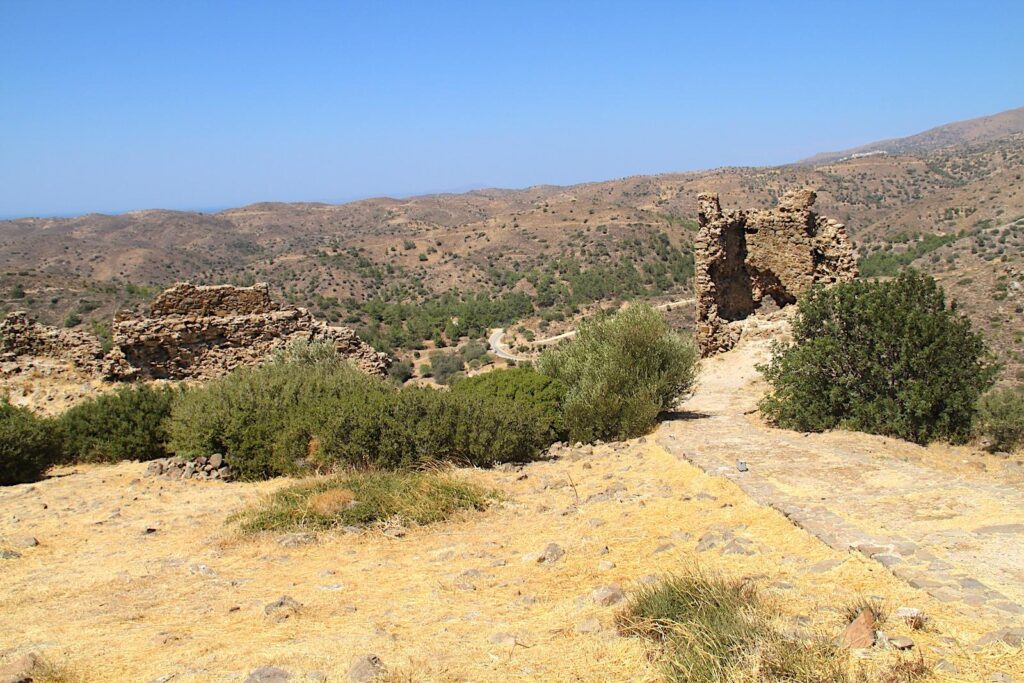
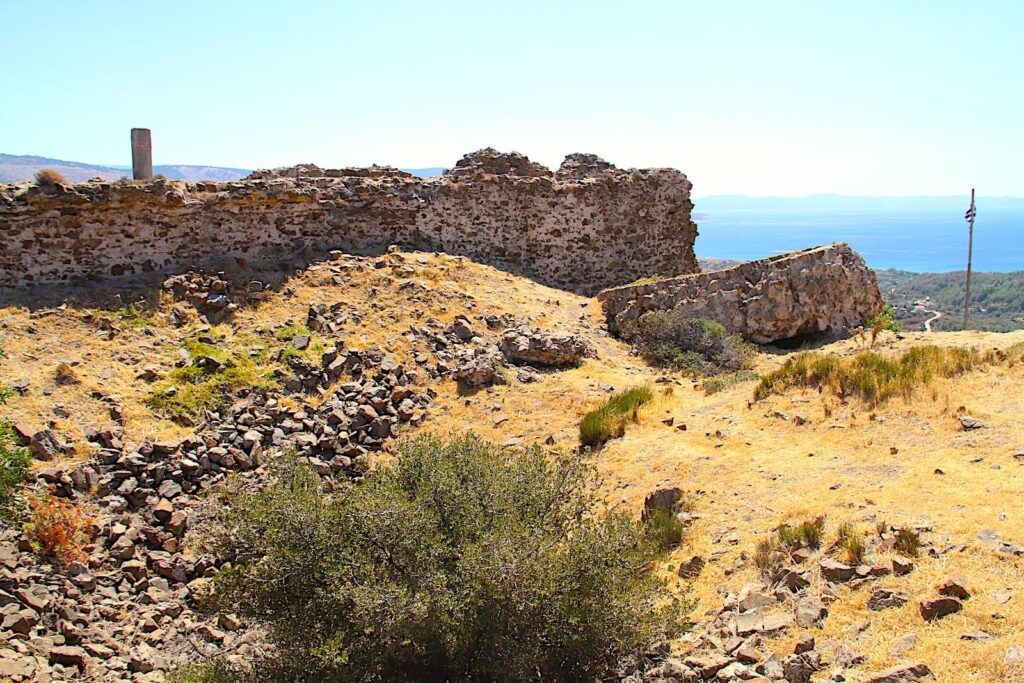
The Agio Galas Cave
Location: Agio Galas Cave (σπήλαιο Αγίου Γάλακτος) Agio Gala, Chios 821 03, Greece. 60km northwest of Chios Town.
The Agio Galas Cave is a fascinating natural and historical site located in the northwestern part of Chios, near the village of Agio Galas. The cave is renowned for its stunning geological formations, archaeological significance, and connection to ancient myths and local traditions. It is a limestone cave system that extends deep into the hills near the village and consists of multiple chambers, each featuring impressive stalactites and stalagmites formed over thousands of years. The cave is divided into three main sections, including the upper, middle, and lower caves; each section has unique features, with the lower cave being the largest and most accessible to visitors.
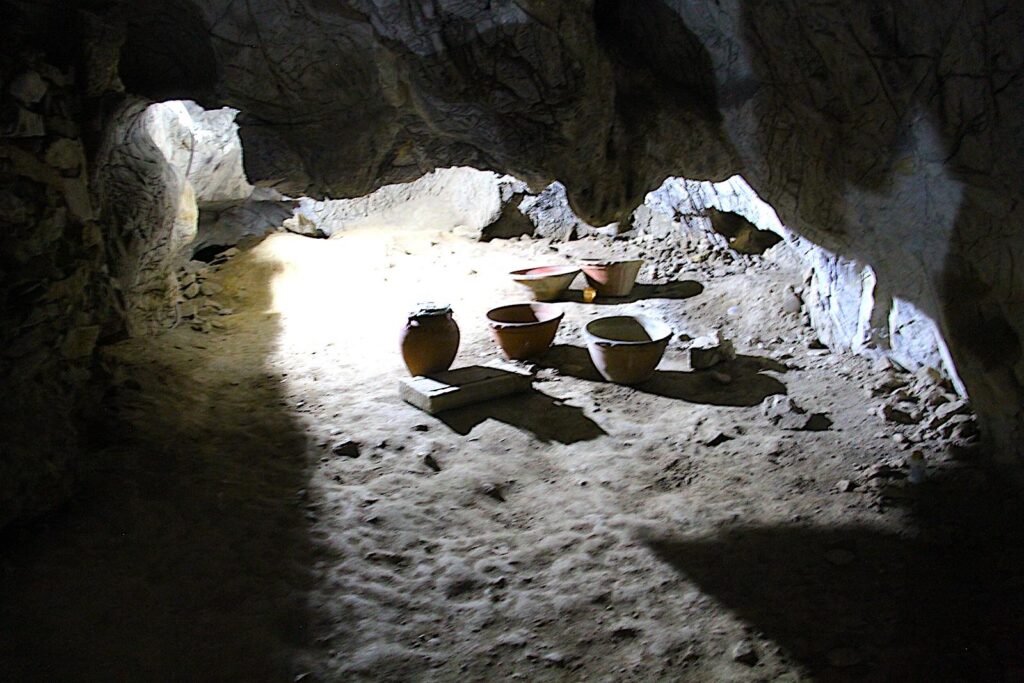

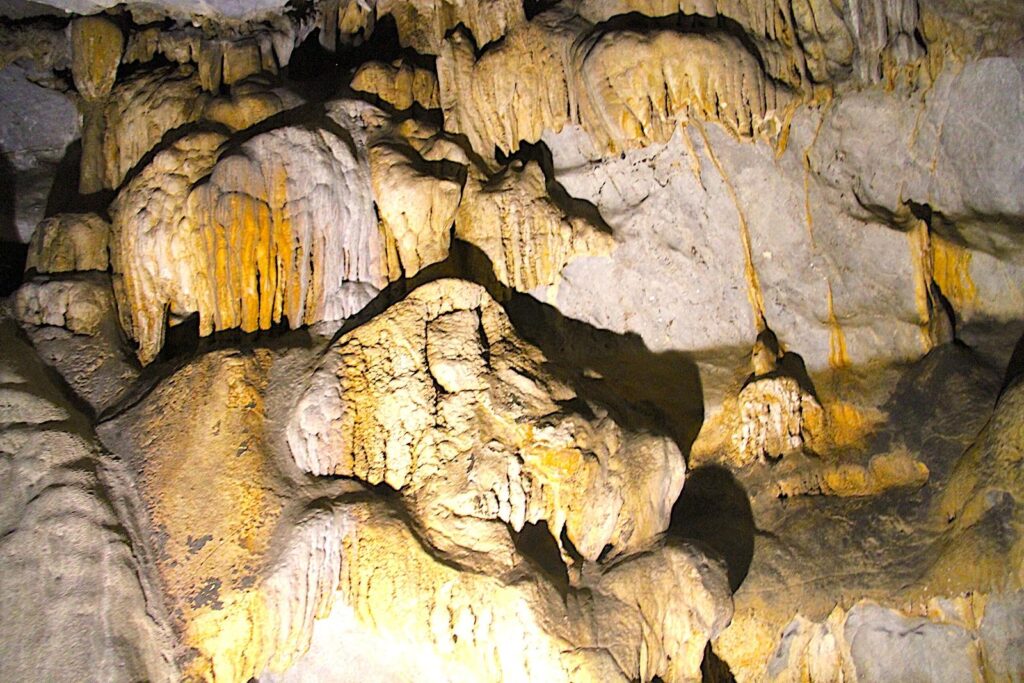
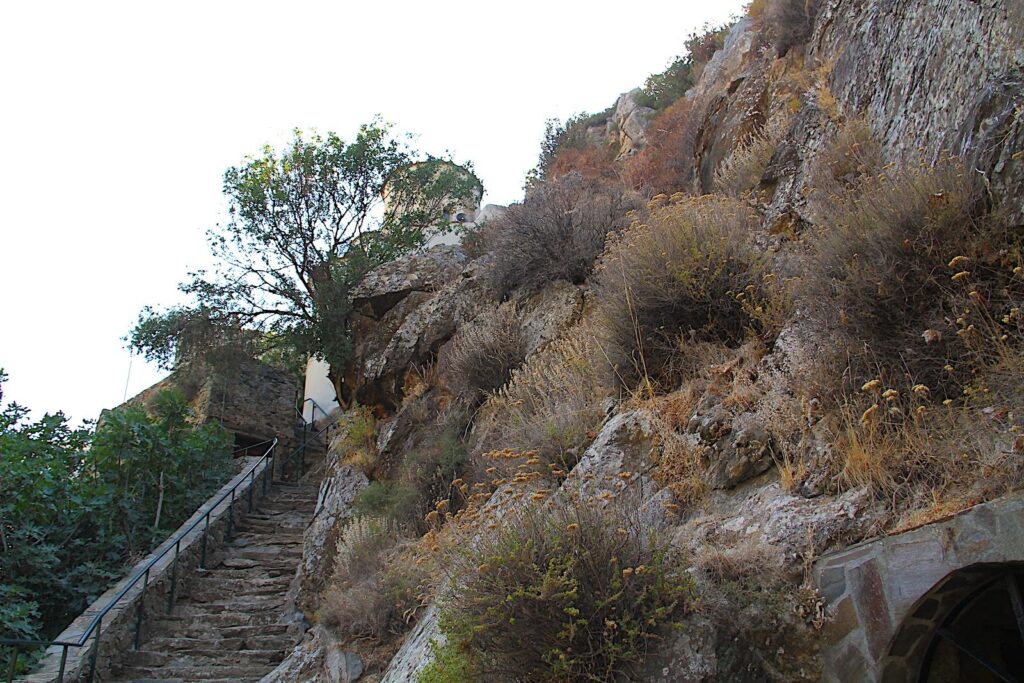

Archaeological excavations in the Agio Galas Cave have uncovered artefacts dating back to the Neolithic and Bronze Ages. The cave is believed to have been a sanctuary dedicated to a fertility goddess in ancient times. Inside the cave is a small Byzantine chapel dedicated to the Virgin Mary, known as Panagia Agiogalousaina, which was thought to have been built in the 13th century and is still a place of pilgrimage for locals. “Agio Galas” means “Holy Milk,” referring to the legend that the Virgin Mary provided milk to a child in the cave. According to local legend, the cave was once a place where women would come to pray for fertility, suggesting that the cave’s waters had spiritual properties that could aid in conception.
Ariousios Winery
Location: Amani, Egrigoros 821 03, Chios, Greece: 55km northwest of Chios Town. English Website
The Ariousios Winery opened in 2009 and is a modern winery reviving the island’s famed ancient winemaking traditions. The name “Ariousios” comes from the famous “Ariousian wine” of antiquity, celebrated throughout the Mediterranean for its high quality and unique flavours. This winery seeks to continue that legacy, producing premium wines that reflect the island’s distinct terroir in the fertile Amani region, benefiting from the island’s volcanic soil, favourable microclimate, and proximity to the Aegean Sea. These conditions produce robust and aromatic wines, primarily from indigenous grape varieties such as (for red) Chiotiko Krassero, Agiannitis and Avgustiatis, and (for white) Assyrtiko and Athiri. The Chiotiko Krassero grape variety used for producing the semi-sweet “Glikazon” is spread under the sun to increase the sugar level, per ancient tradition. The Ariousios Winery combines traditional winemaking techniques with modern technology. It offers a variety of wines, including red, white, and rosé, focusing on full-bodied, rich flavours that strongly connect to the island’s unique character. The winery is open for visitors Monday-Saturday 09:00-16:00 (Saturday until 15:00), offering wine tastings (advance booking required) and tours where guests can explore the winery and vineyards, learn about the winemaking process and enjoy the scenic views of the surrounding landscape.
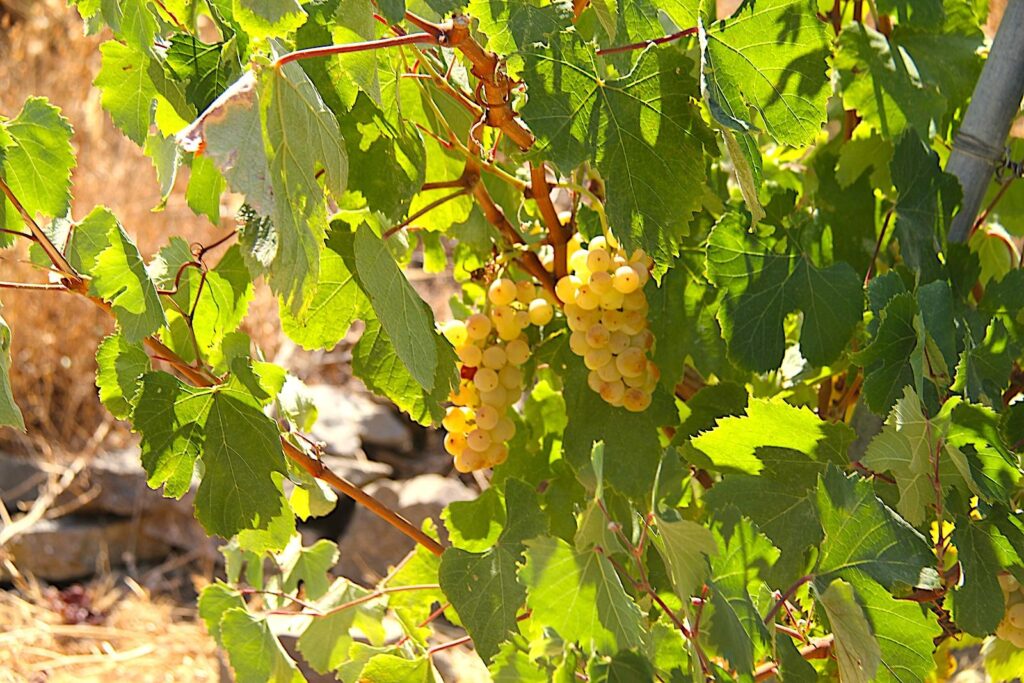
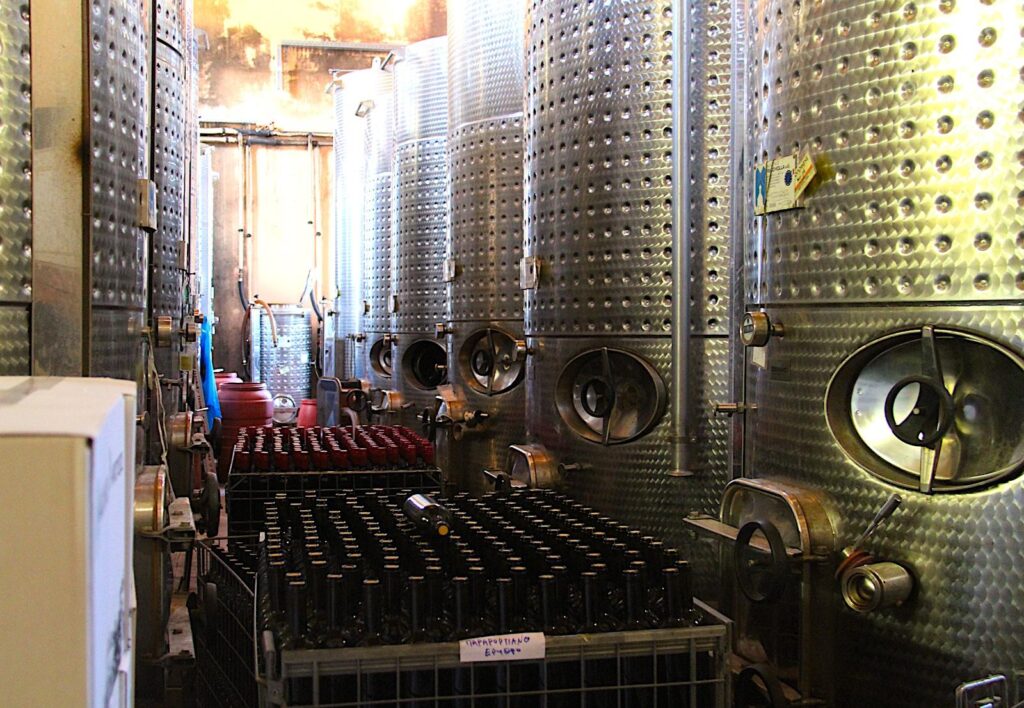
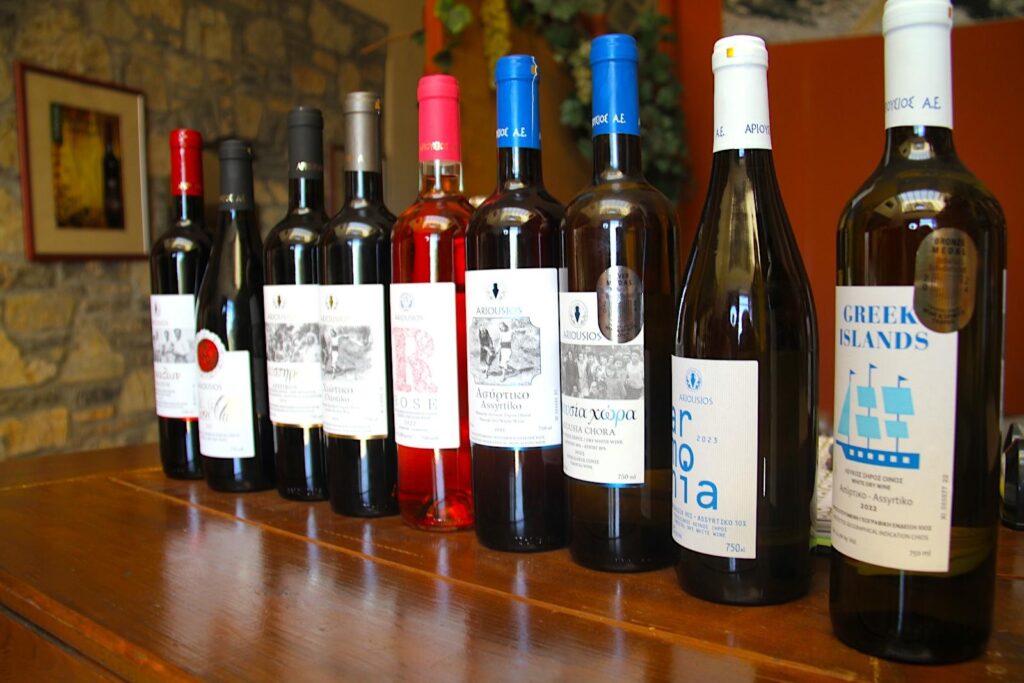
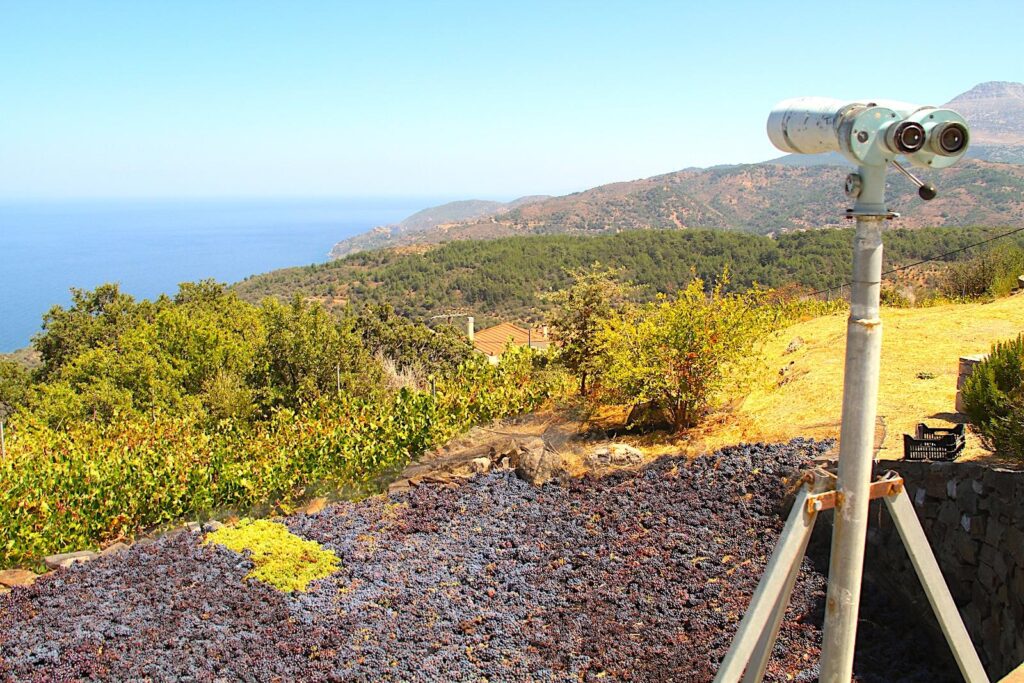
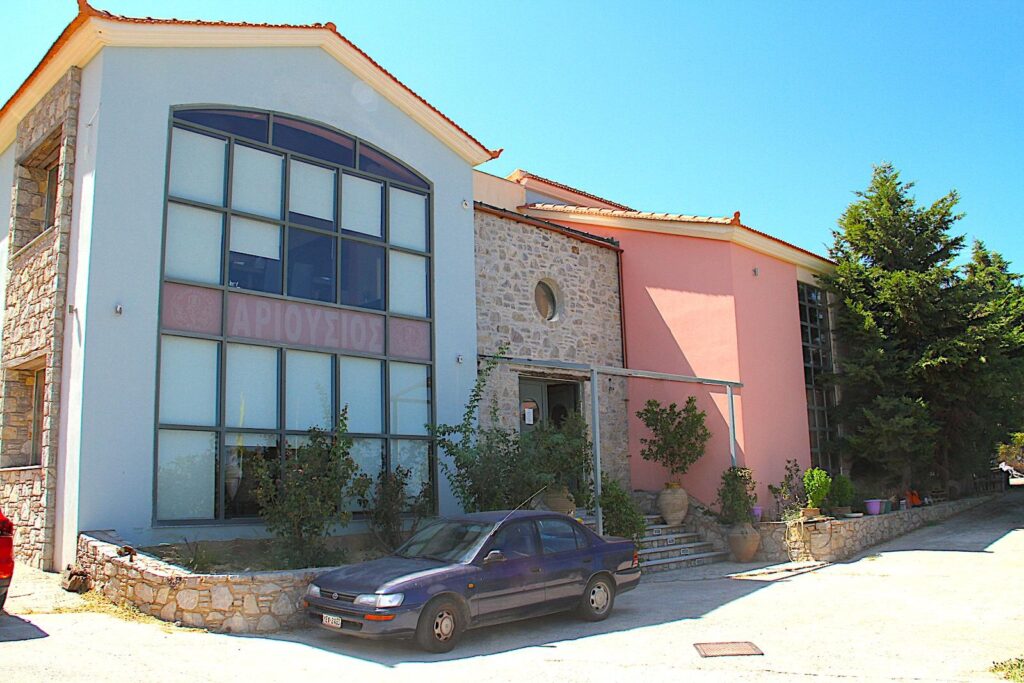
According to the Chian historian Theopompus (378/377-315 B.C.), Oenopion, son of the god Dionysus, taught the Chians to cultivate vines and produce the famed “black wine” in antiquity. The people of Chios proudly offered their wine, promoting what Homer had called “sparkling black wine.” The geographer Strabo (64/63 B.C. – 24 A.D.) defines Ariousia Chora, the land between the mountain “Pelinnaion” and the cape of “Melana Akra” as an area “…producing the most excellent among Greek wines” in northwest Chios. The Romans consumed Ariousios wine, and Latin poets such as Horace and Virgil praised the wine in their poems. Its fame continued in Byzantium, when, according to the Byzantine emperor Constantine VII Porphyrogenitus (905-959 A.D., reign 913-959 A.D.), the Chian wine was offered at the imperial table as “the strongest,” and according to the Byzantine-Greek monk Michael Psellos (1018-1096 A.D.), “… it nourishes the nature of the body…”
Anavatos Ghost Town
Location: Anavatos, Chios 82100, Greece. 21km west of Chios Town.
Anavatos is a remarkable medieval village located in the central part of Chios, perched on the edge of a cliff on the slopes of Mount Provatas, overlooking the surrounding hills and valleys. Known as the “Mystras of the Aegean” for its fortress-like appearance, Anavatos is an important historical and cultural site on the island, symbolising resilience and tragedy. The village is built at an altitude of about 450 metres, constructed on a natural plateau, with buildings made of stone that blend seamlessly with the rocky terrain. Anavatos was founded during the Byzantine period, likely in the 10th or 11th century, as a defensive settlement against pirate attacks. “Anavatos” means “inaccessible” in Greek, reflecting the village’s difficult-to-reach location, which protected its inhabitants.
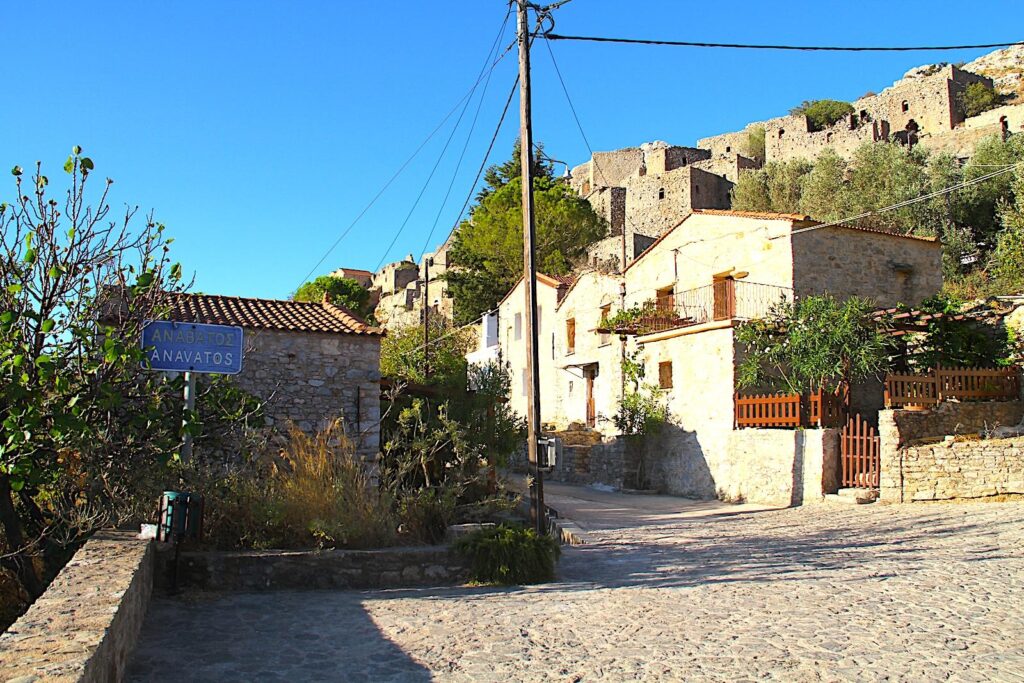
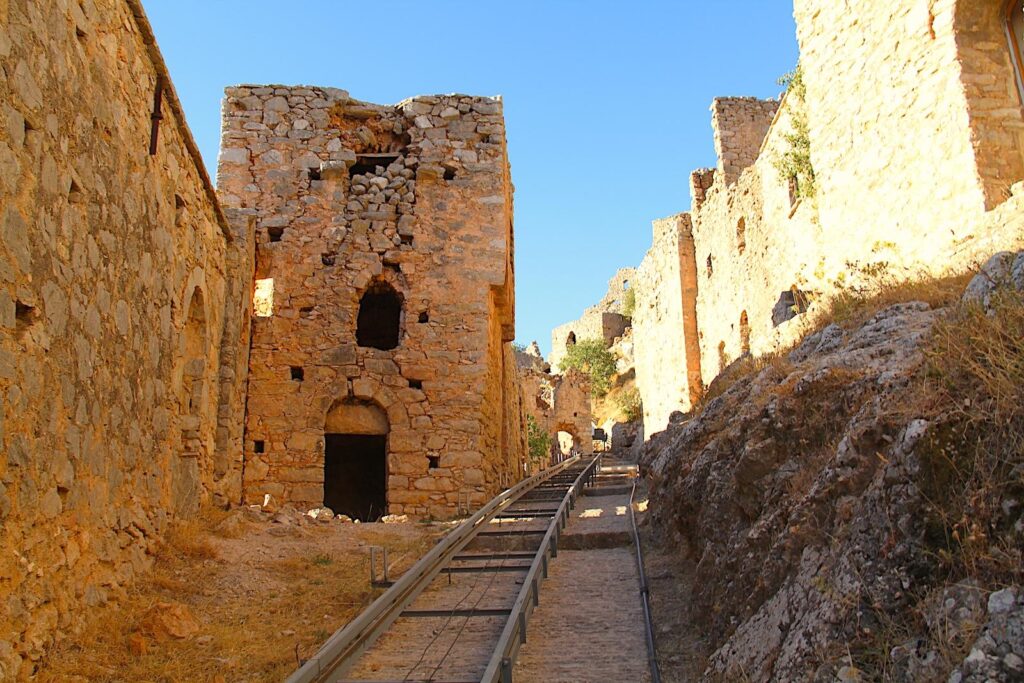
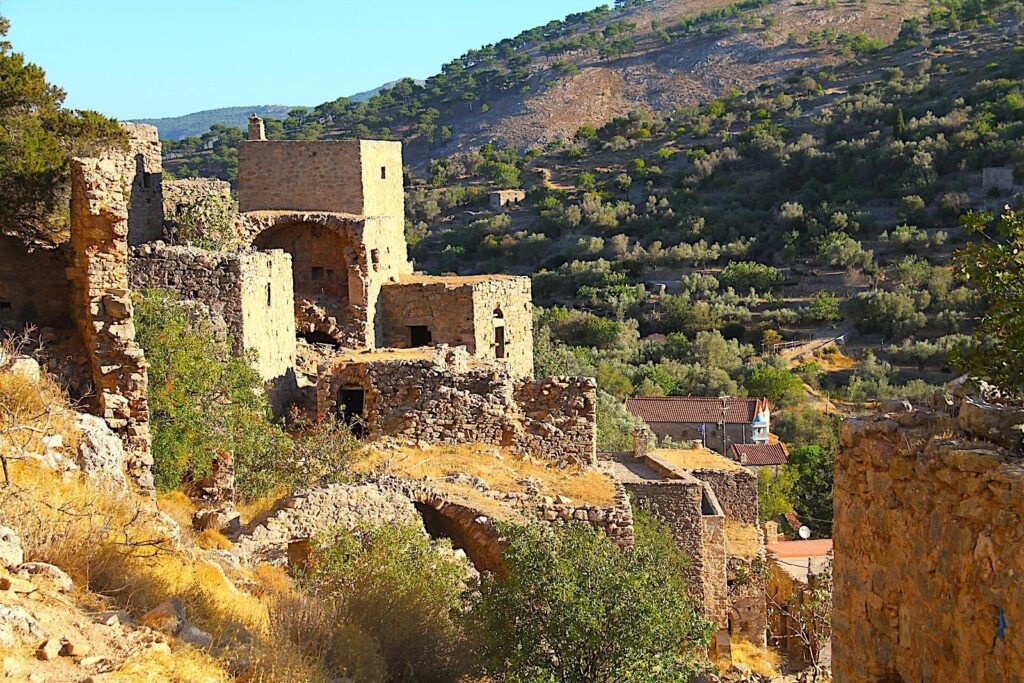
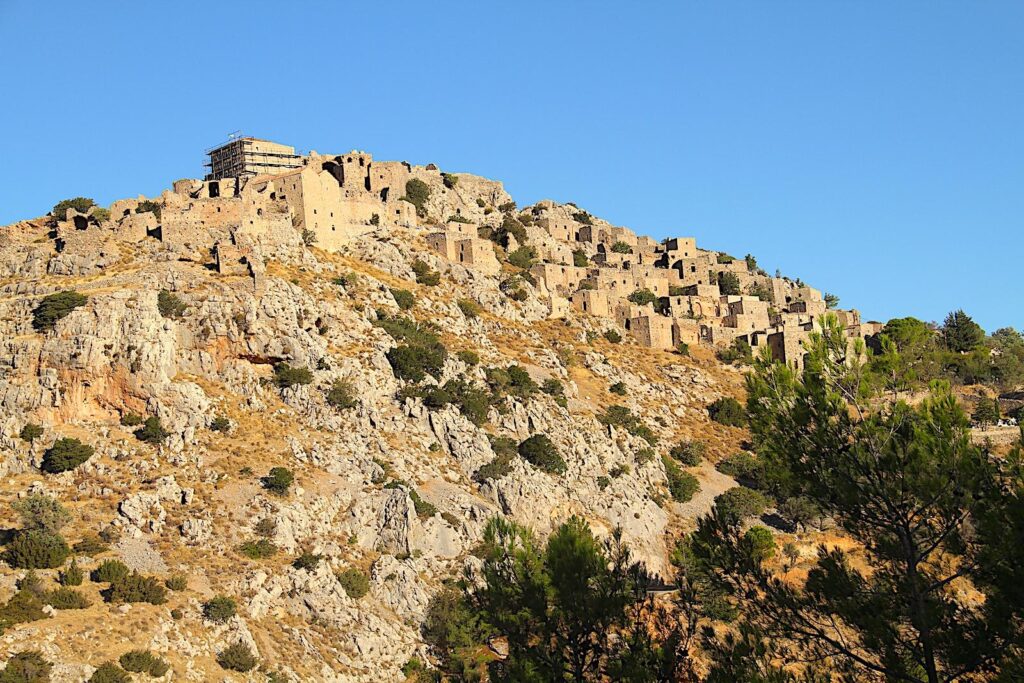

The village population peaked during the Ottoman period, particularly in the 18th century, when it served as a refuge during various conflicts, including the Greek War of Independence. Anavatos is most famously associated with the tragic events of the Chios Massacre of 1822 in response to the island’s involvement in the Greek War of Independence. Many of the village’s residents either fled, were killed, or chose to leap from the cliffs rather than be captured, leading to the village’s near-abandonment.
It was built with a defensive layout, with narrow, winding streets and houses closely packed together to form a protective wall. The village’s natural surroundings add to its defensive capabilities, making it a near-impenetrable fortress. The town is home to several historical churches, including the Church of the Taxiarchis (Archangel Michael), which dates to the 14th century and features beautiful frescoes. Another significant church is the Church of the Virgin Mary, located at the village’s highest point. The central tower, which served as a lookout and last line of defence, remains a prominent feature of Anavatos. Today, Anavatos is mainly uninhabited, with many buildings in ruins. However, its well-preserved structures, haunting atmosphere, eerie silence, and dramatic location create a powerful impression of the past. Due to the terrain, wearing comfortable shoes for walking is advisable.
Pygrgi Medieval Village
Location: Pygrgi (Πυργί), 82102, Greece. 25km southwest of Chios Town.
Pyrgi is a visually striking medieval village known for its unique architecture, rich history, and vibrant cultural heritage. It is often referred to as the “painted village” due to the intricate geometric designs that adorn the facades of many of its buildings. Pyrgi dates to the Byzantine period, but it reached its current form during the Genoese occupation of Chios, which lasted from 1346 to 1566. The village was built as a fortified settlement to protect its inhabitants from pirate raids and other external threats. Under Genoese rule, Pyrgi became one of the island’s most important mastic-producing villages. Designed as a maze-like village with narrow, winding streets to confuse invaders, the village’s houses are closely packed together, creating a solid defensive wall along the outer perimeter. The village features several tower houses originally built as defensive structures. These multi-story buildings provided living space and protection, with narrow windows and thick walls designed to withstand attacks.
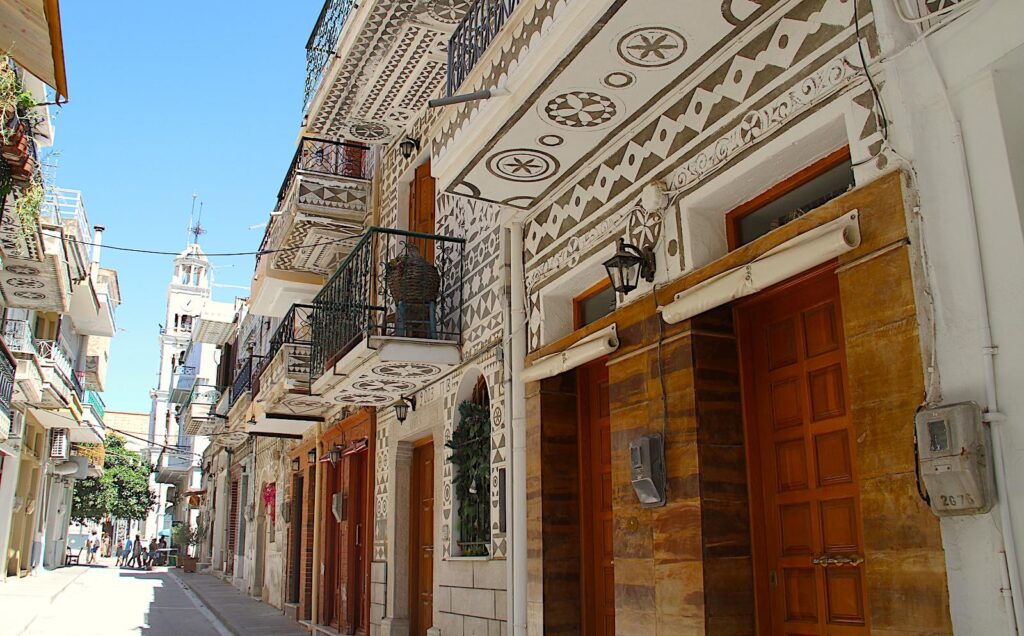
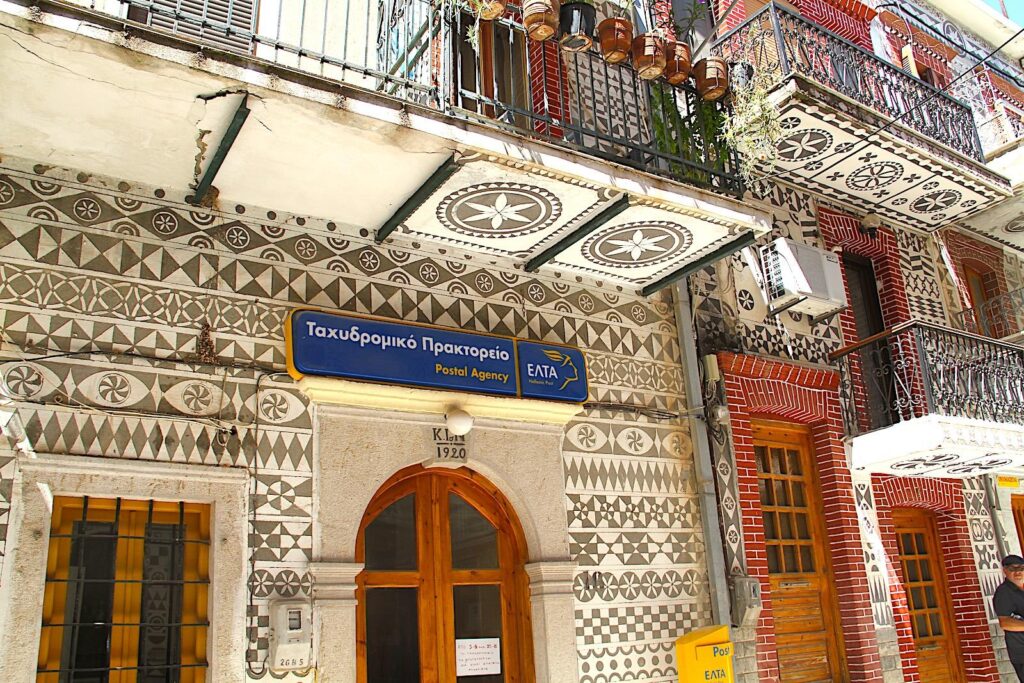
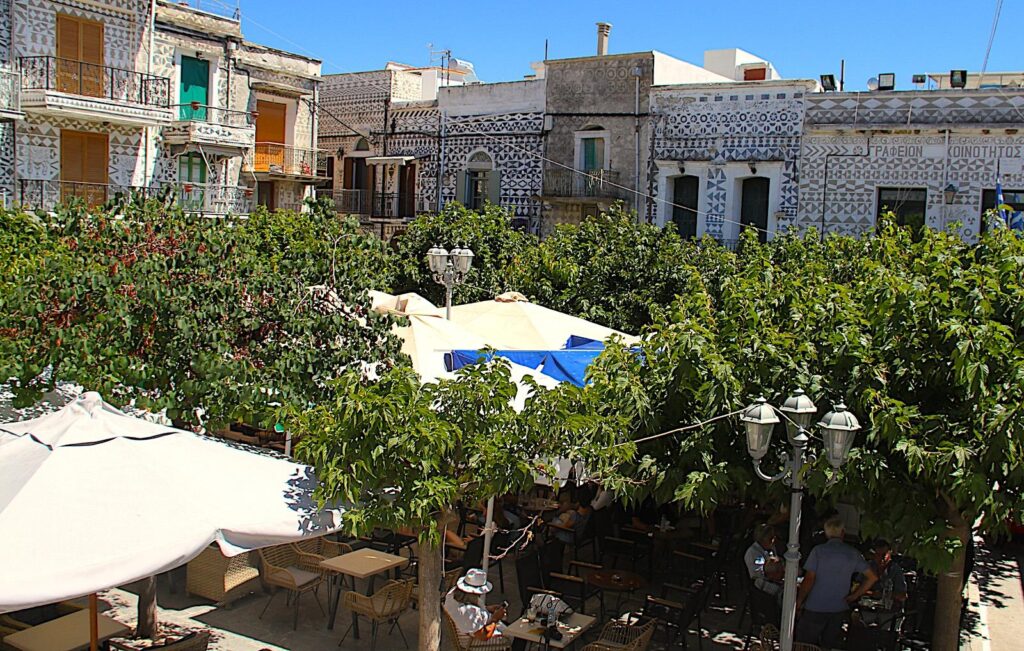
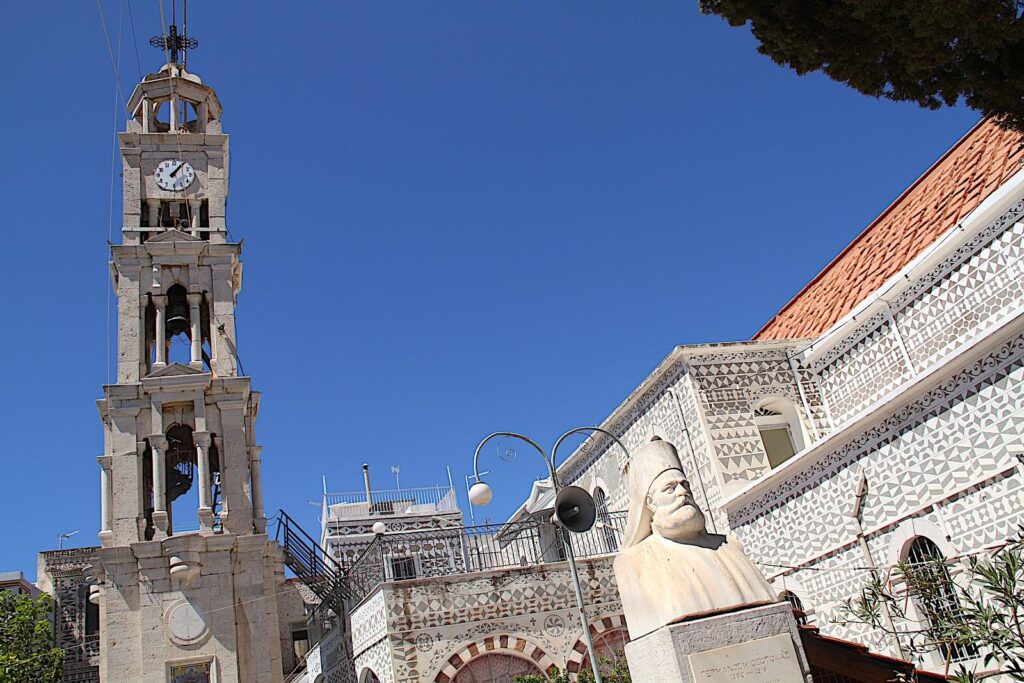

One of the most distinctive features of Pyrgi is the “xysta” decoration on the façades of its buildings. The xysta are intricate geometric patterns carved into the plaster, creating a black-and-white effect that is visually stunning. They are created by applying layers of plaster and then scratching away parts of the upper layer to reveal the darker layer beneath. The patterns include diamonds, circles, triangles, and other shapes, each handcrafted. The Church of the Dormition of the Virgin Mary is an example of the village’s rich ecclesiastical architecture; it dates to the 13th century and features elements of Byzantine and Genoese design, adorned with stunning frescoes and religious icons.
Visitors to Pyrgi can also enjoy the local cuisine, which often features mastic as an ingredient. Mastic is used in various traditional dishes, desserts, and drinks, offering a taste of the village’s unique cultural heritage. Pyrgi hosts several cultural events throughout the year, including religious festivals, mastic-related celebrations, and traditional music and dance performances.
The Chios Mastic Museum
Location: Pyrgi, Thesis Rachi (Πυργί, Θέση Ράχη), Chios 821 02, Greece. The Chios Mastic Museum English Website – Open Wednesday-Monday 10:00-18:00 (winter until 17:00) – Entrance €4.00 as of August 2024.
The Chios Mastic Museum was created to preserve and promote the heritage of mastic cultivation on Chios, which has been a vital part of the island’s economy and culture for centuries. It is centred on the history, cultivation, and cultural significance of mastic, a resin derived from the mastic tree (Pistacia lentiscus var. chia) that grows exclusively on the southern part of Chios island. The Piraeus Bank Group Cultural Foundation established the museum and officially opened it publicly in 2016. The museum provides a comprehensive overview of the history of mastic cultivation on Chios, tracing its origins back to antiquity. It explores how mastic became a valuable commodity in the Byzantine and Genoese periods and how it has been traded and used across the Mediterranean and beyond.
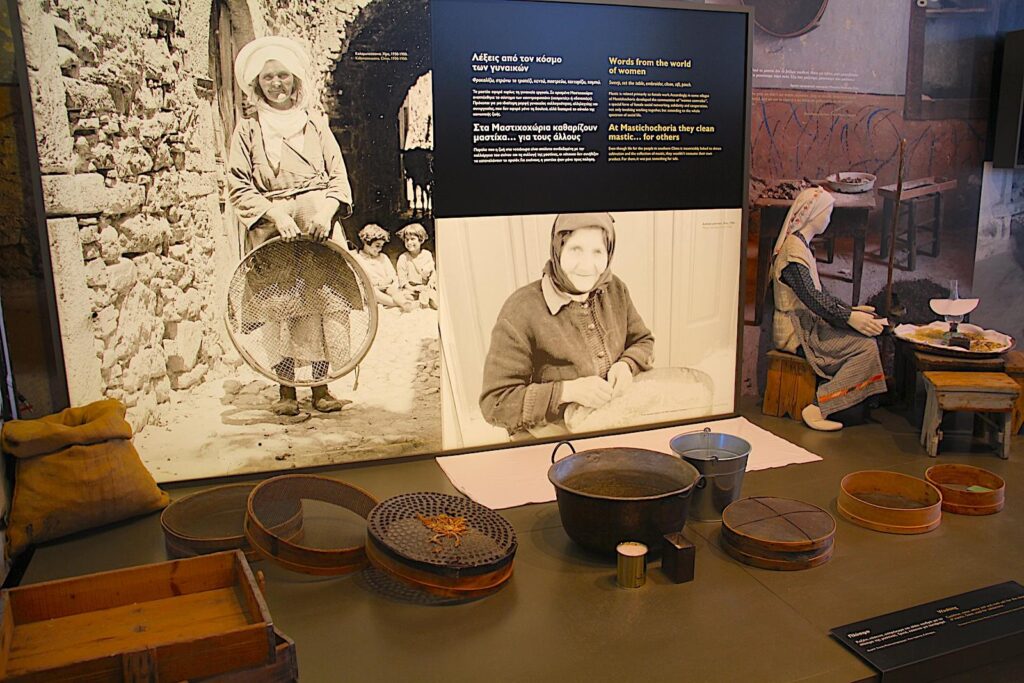

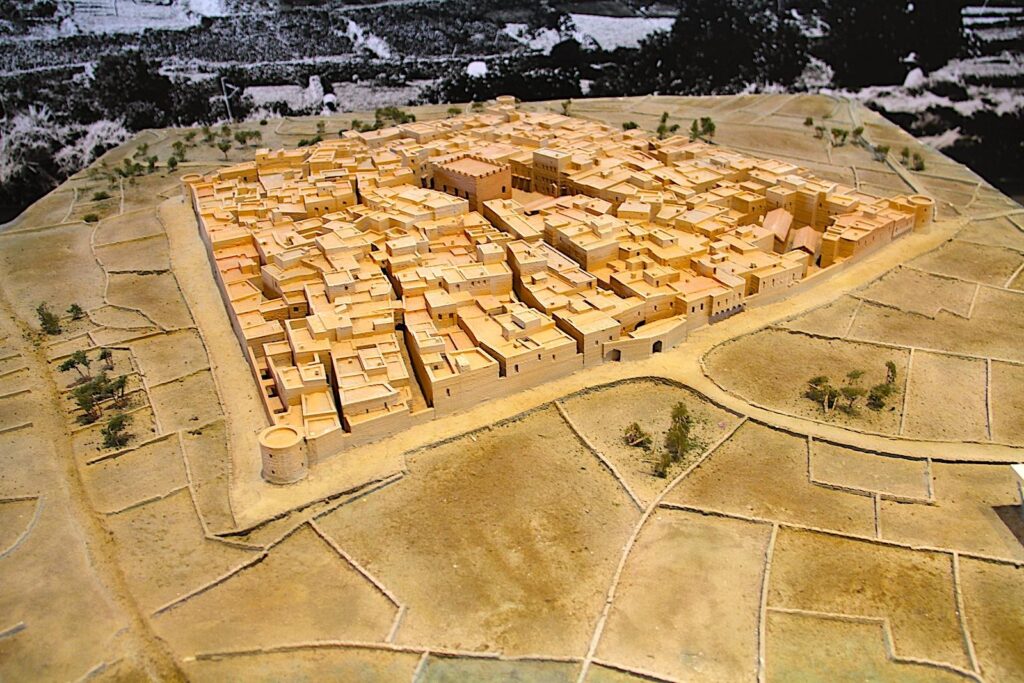

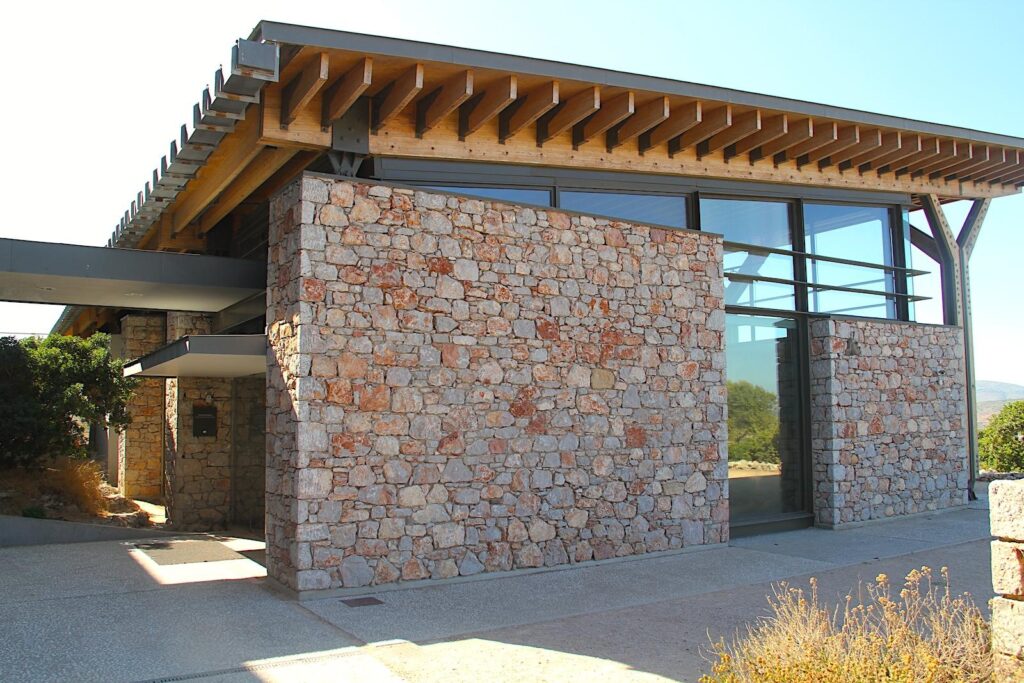
One of the key exhibits in the museum is dedicated to the traditional methods of mastic cultivation and harvesting, featuring tools, photographs, and video presentations that illustrate the labour-intensive techniques used by mastic growers. The museum also explores the cultural aspects of mastic production, including its role in the social and religious life of the island’s inhabitants. Mastic has been used in various rituals, culinary traditions, and medicinal practices, and these uses are highlighted in the museum’s displays. Another section of the museum is dedicated to the economic importance of mastic, examining how mastic has shaped the economy of Chios, particularly in the Mastichochoria region (the “mastic villages”), and its role in international trade. The exhibit also touches on modern uses of mastic in industries such as cosmetics, pharmaceuticals, and food production. Visitors can see and smell different mastic forms or try their hand at traditional mastic harvesting techniques in a simulated environment. The museum features a gift shop where visitors can purchase mastic products, including gum, sweets, cosmetics, and more. There is also a café that serves refreshments and snacks made with mastic, allowing visitors to sample the unique flavours of this local product.
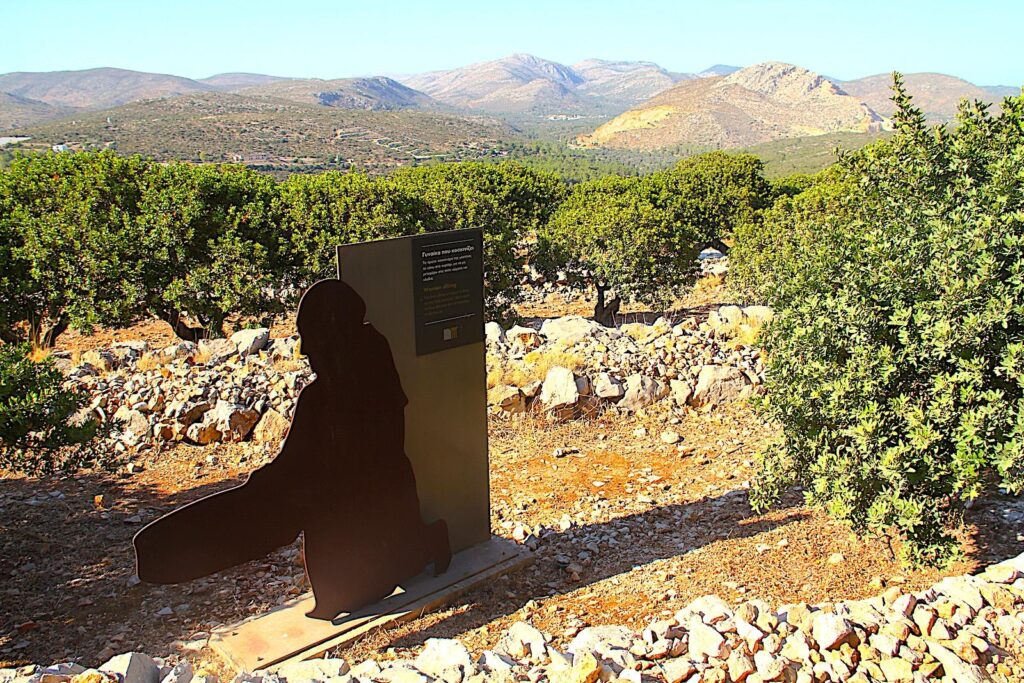
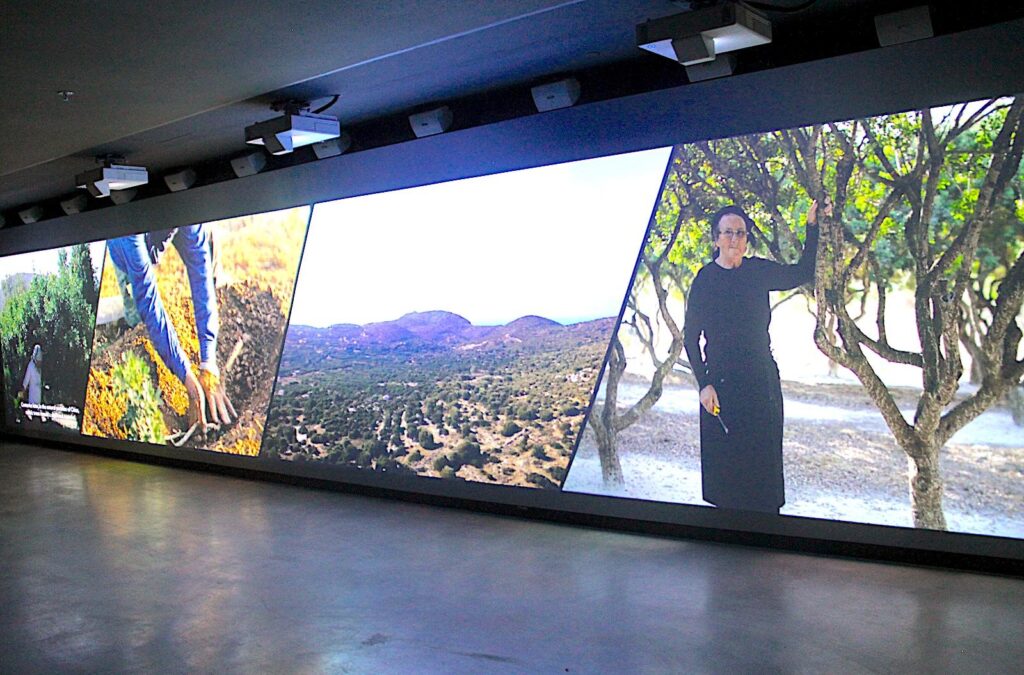
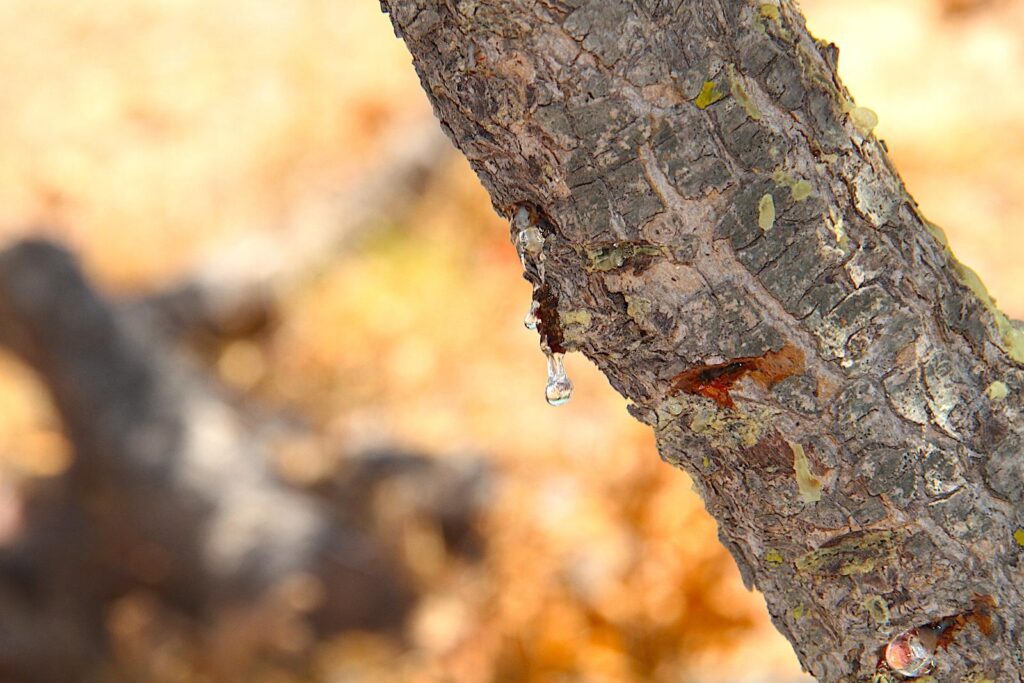
Mesta Medieval Village
Location: Mesta (Μεστά) Chios 821 02, Greece. 35km southwest of Chios Town.
Mesta is one of the most well-preserved medieval villages on the island and is renowned for its distinctive architecture, rich history, and strong ties to the island’s mastic production, being part of the “Mastichochoria” group of villages. Mesta was built during the Byzantine period, around the 14th century, and later fortified by the Genoese, who controlled Chios from the 14th to the 16th century. The village was designed as a fortress to protect its inhabitants from pirate raids and other threats. Its strategic design reflects the need for protection and self-sufficiency during periods of conflict. The village has a labyrinthine layout with narrow, winding streets designed to confuse invaders. This layout also allowed the villagers to defend themselves more effectively, as attackers could be easily trapped or ambushed within the complex network of alleys.
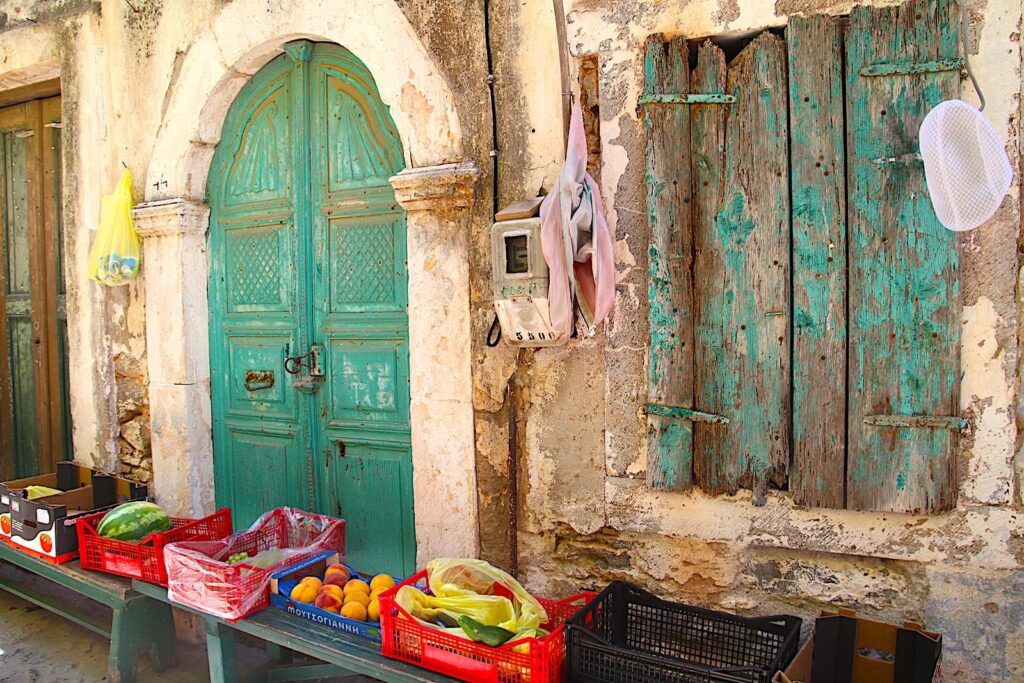
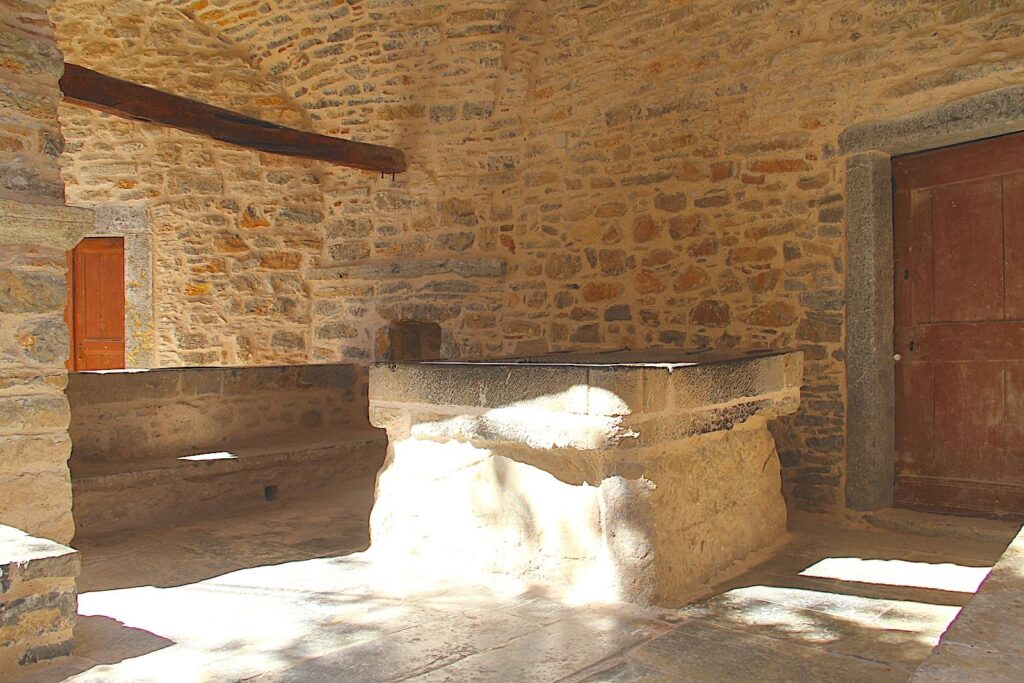

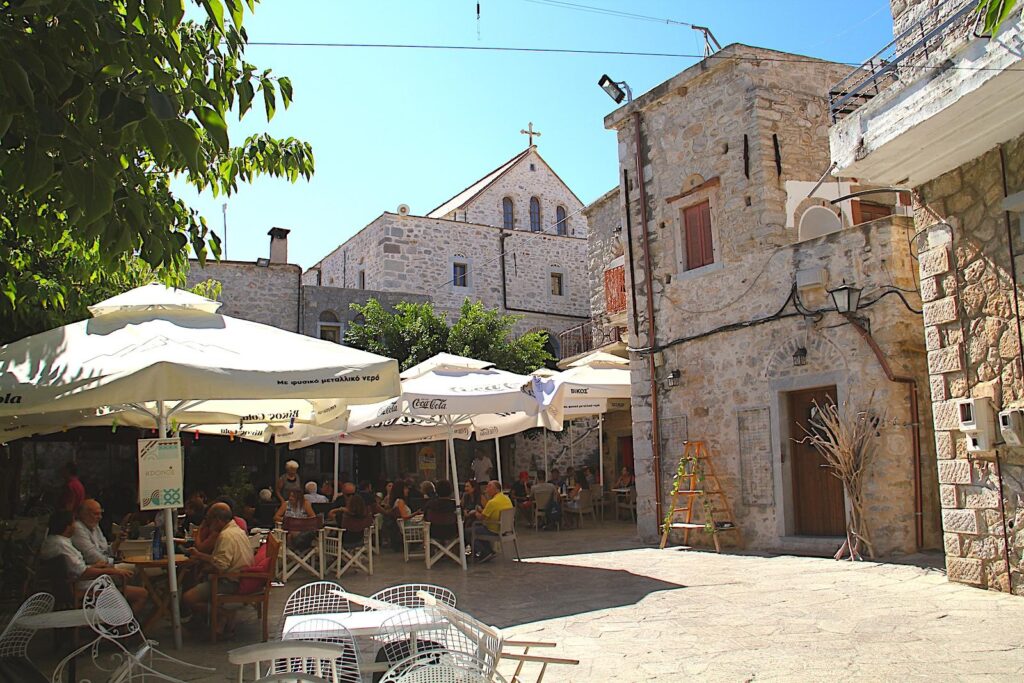
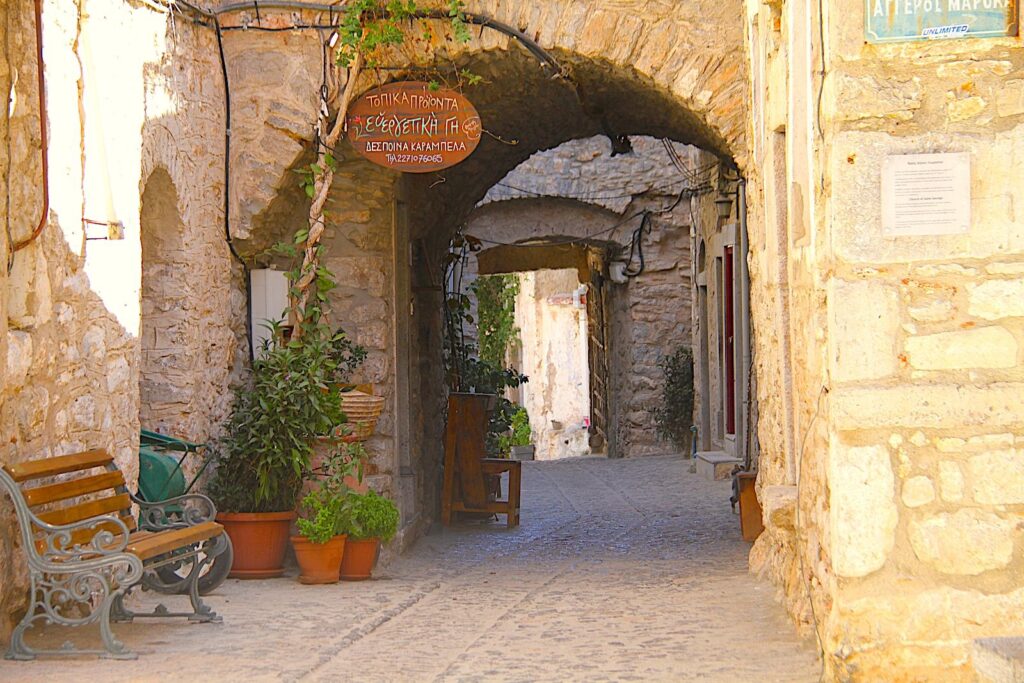
Mesta is surrounded by thick stone walls with only a few entrances, and many of the houses are tower-like structures with flat roofs, which could be used as lookout points or for defence. Arches connect these houses, and the roofs often serve as walkways for villagers during sieges. At the heart of the village is the central tower, originally used as a refuge during attacks. One of the most significant religious sites in Mesta is the Church of the Palaios Taxiarchis (Old Church of Archangels), dedicated to the Archangels Michael and Gabriel with elaborate Byzantine frescoes and icons, reflecting the deep religious heritage of the village. Another important religious site is the Church of Megalos Taxiarchis (New Church of Archangels), the largest church in Chios, built in the 19th century. Its impressive size, beautiful architecture, and rich interior decoration stand out. The Tower of Milatas on the village’s northwest side is named after the guards who protected the village. It has a sizeable 18-metre-deep well used by the guards in times of peace and by the villagers in times of siege.
Olympi Medieval Village
Location: Olimpi (Ολύμποι), Chios 821 02, Greece. 32km southwest of Chios Town.
Olympi is one of the well-preserved medieval villages on the island of Chios, located in the southwestern part of the island. It is known for its unique architecture, rich history, and the famous Olympi Cave. Approximately 32 km from Chios Town in the Mastichochoria region, between the medieval villages of Pyrgi and Mesta, the town forms part of the region’s historical network of fortified settlements. Olympi dates back to the 14th century when the Genoese rule of Chios was in force. Like other Mastichochoria, it was built as a defensive settlement to protect the valuable mastic crops from pirates and invaders. The village was designed with a fortress-like structure, narrow, winding streets, and closely packed houses forming a continuous outer wall.
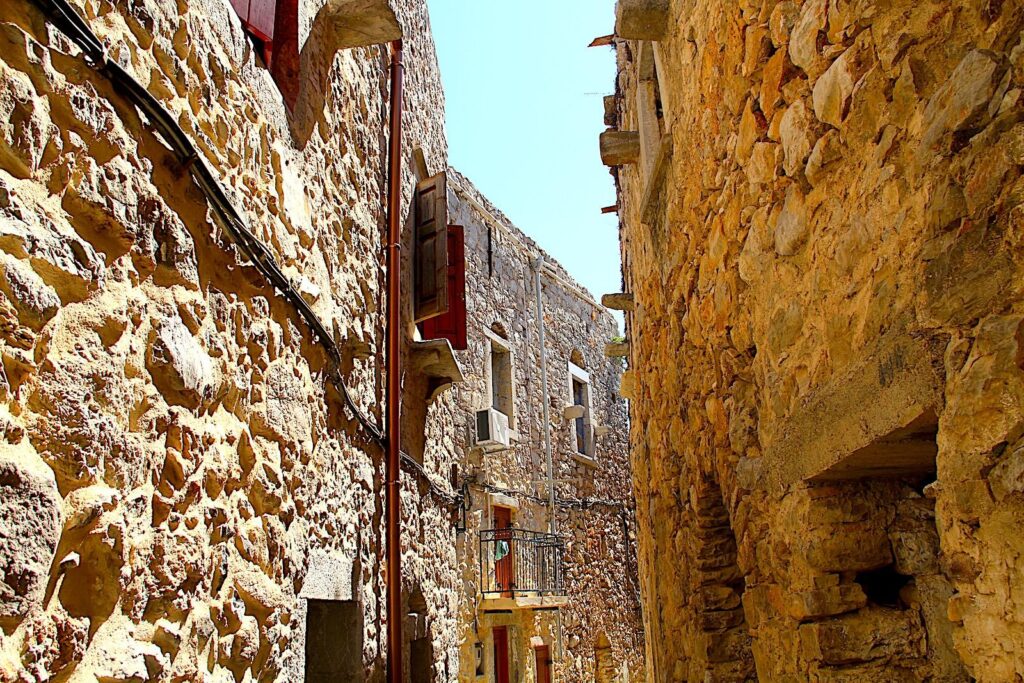
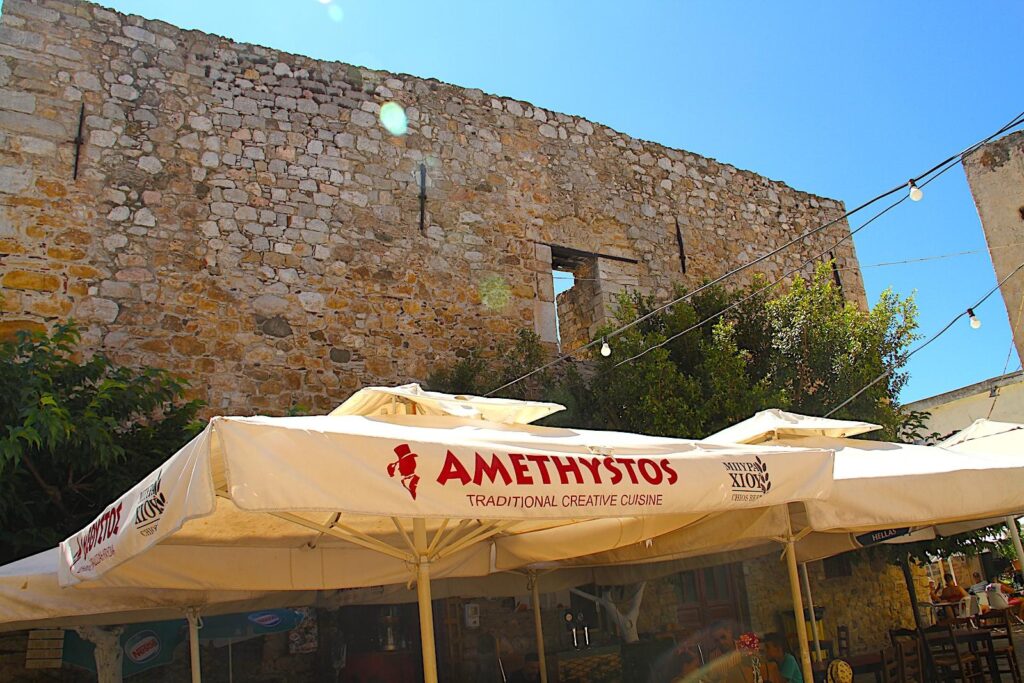

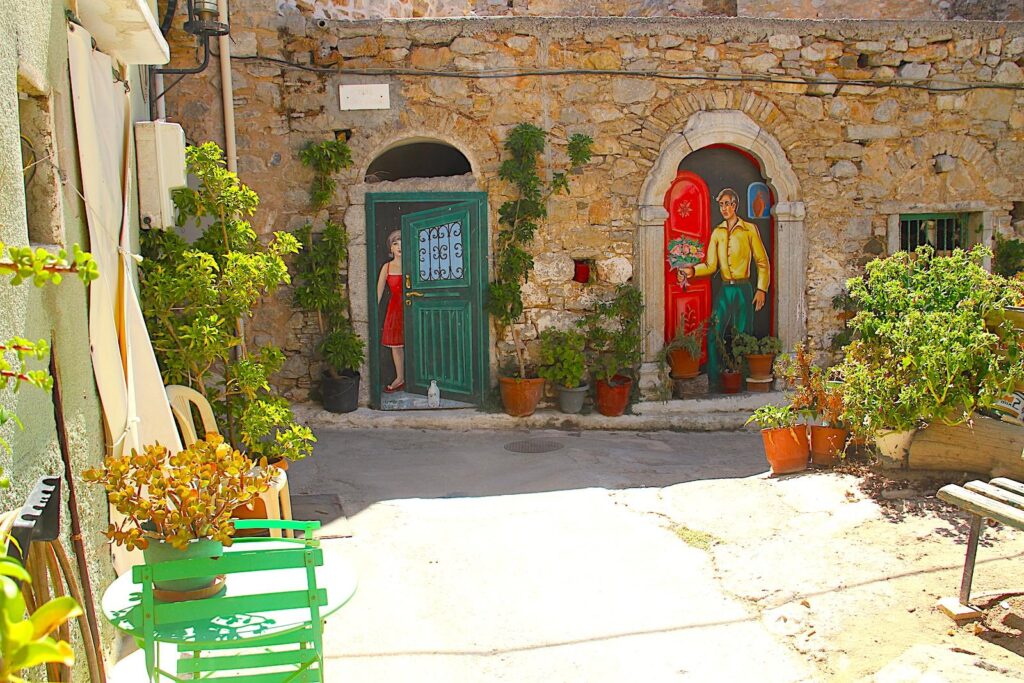
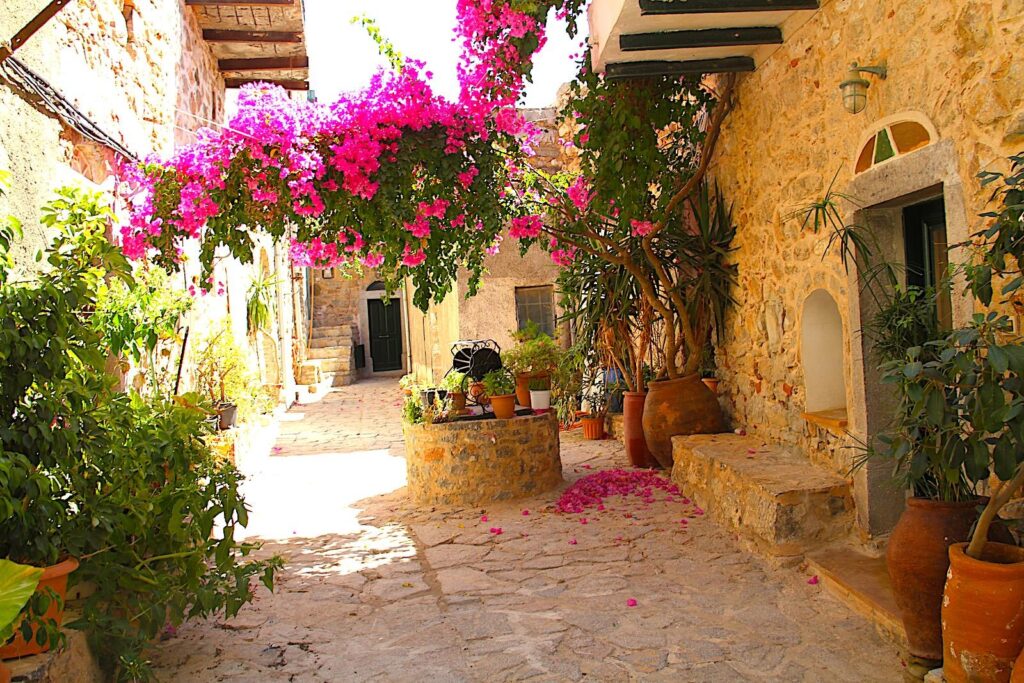
The village’s architecture is characterized by its dense, labyrinthine street plan; narrow, winding alleys were designed to confuse and slow down attackers, while the houses were built with thick stone walls to withstand sieges. At the heart of the village stands a central tower, or pyrgos, which served as a lookout and last refuge during invasions. The tower is one of the most distinctive features of Olympi and a reminder of its defensive past. The houses in Olympi often feature arched doorways, vaulted ceilings, and small windows, reflecting the medieval architectural style prevalent during the Genoese period. The main church of the village, dedicated to Agia Paraskevi, is another notable building. It features typical Byzantine-style architecture and serves as a central place of worship for the community. Like other villages in the Mastichochoria region, it has a long history of mastic cultivation.
Olimpi’s Cave (Sykia Cave)
Location: Olimpi’s Cave (Σπήλαιο των Ολύμπων), Olimpi, Chios 821 00, Greece. 35km southwest of Chios Town.
1.5km from Agia Dinami Beach, on the route from the village, is Olimpi’s cave, also known as Sykia Cave, a fascinating natural renowned for its impressive stalactites and stalagmites, which have formed over thousands of years, creating a mesmerising underground landscape. Inside the 57-metre-deep cave, visitors can marvel at various stunning limestone formations. The stalactites and stalagmites, formed initially in the Upper Jurassic Period 150 million years ago and completed 50 million years ago in the Cenozoic Period, create an otherworldly environment. It consists of a large chamber and a long room. The temperature remains steady at 17 Celsius, and the humidity is 95%. The cave is accessible to visitors through guided tours to ensure the preservation of the delicate formations. The tour takes you through several chambers, each with its unique features, illuminated to highlight the intricate details of the formations.
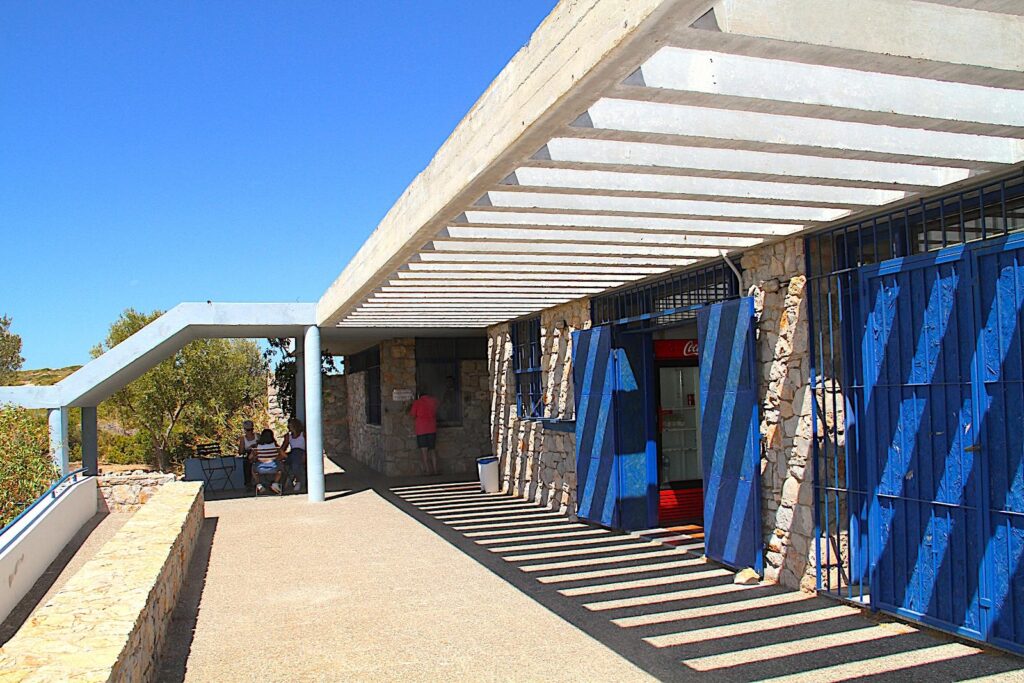
Beaches of Chios
Chios is an island with a diverse coastline, offering various beaches that cater to all kinds of preferences, from secluded coves to more popular spots with amenities. In total, Chios boasts 92 beaches, which are said to be “the same as the number of summer days…”. Below is an overview of the main beaches of Chios, categorised by their location on the island. Eastern Coast: Most developed and easily accessible, featuring a mix of sandy and pebbly beaches. This side of the island faces the coast of Turkey and is home to many of the island’s most popular beaches. Includes Karfas Beach, Agia Fotini (Agia Fotia), Daskalopetra Beach, Megas Limnionas, Komi Beach, and Agios Emilianos. Western Coast: The western coast of Chios is less developed and more rugged, offering secluded beaches with stunning natural scenery. This side of the island faces the open Aegean Sea. Includes Lithi Beach, Tigani Beach, Trachili Beach, and Managros Beach. Northern Coast: The northern coast of Chios is characterised by its rugged terrain and relatively fewer beaches, but those that exist are known for their natural beauty and peaceful atmosphere. Includes Nagos Beach, Giosonas Beach, and Agia Markella Beach. Southern Coast: The southern coast of Chios is known for its mastic-producing villages and several beautiful beaches, some of which are among the most famous on the island. Includes: Broulidia Beach, Mavra Volia, Apothika Beach, Agia Dinami Beach, and Kato Fana Beach.
Managros Beach – Western Coast of Chios
Location: Paralia Managros (Παραλία Μάναγρος), Amani, Chios 821 03, Greece. 37km northwest of Chios Town.
Managros Beach is one of Chios’s largest and most serene beaches in the northwestern part of the island near the village of Volissos. It is known for its expansive stretch of sand, crystal-clear waters, and peaceful ambience, making it a favourite spot for locals and visitors seeking a tranquil seaside escape. The beach is part of a larger bay, along with other Lefkathia and Limnos beaches. The beach is one of the longest on the island, extending over 1.5 km, and its vast size ensures that even during peak tourist season, it remains relatively uncrowded. The beach features a mix of golden sand and small pebbles, with some areas being sandier and others more pebbly. The waters of Managros Beach are exceptionally clear and have a deep blue hue; the gentle slope into the sea makes it ideal for swimming, especially for families with children. The surrounding landscape is dotted with olive groves and low hills; it is relatively undeveloped compared to other beaches on the island, contributing to its quiet and laid-back atmosphere. No large beach bars or resorts exist, but basic amenities, such as sunbeds and umbrellas, are available for rent during summer. Visitors should be prepared with their own supplies, as limited facilities are nearby. The calm waters make it an excellent spot for swimming and snorkelling.
Mavra Volia Beach – Southern Coast of Chios
Location: Mavra Volia Beach, Chios 821 02, Greece. 30km southwest of Chios Town.
Mavra Volia (Black Pebble) Beach, near the village of Emporios in the southern part of Chios, is one of the island’s most stunning and unique natural attractions, often considered one of the most beautiful beaches in Greece. Known for its black volcanic pebbles and crystal-clear waters, the beach offers a striking landscape that sets it apart from other beaches in the Aegean region. The black pebbles result from volcanic activity formed from the remnants of a volcanic eruption in ancient times, which left behind the distinctive black lava pebbles that cover the shore. The pebbles and the deep blue waters of the Aegean Sea create a dramatic and visually striking contrast, a hallmark of the beach. The waters at Mavra Volia Beach are exceptionally clear and clean, making it an ideal spot for swimming and snorkelling.
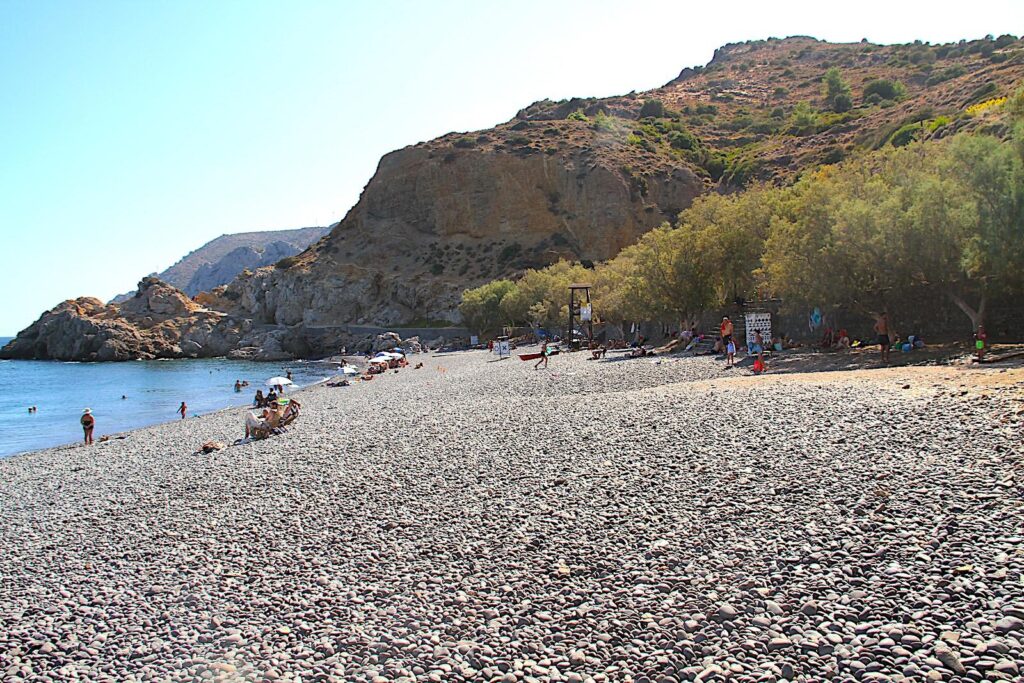
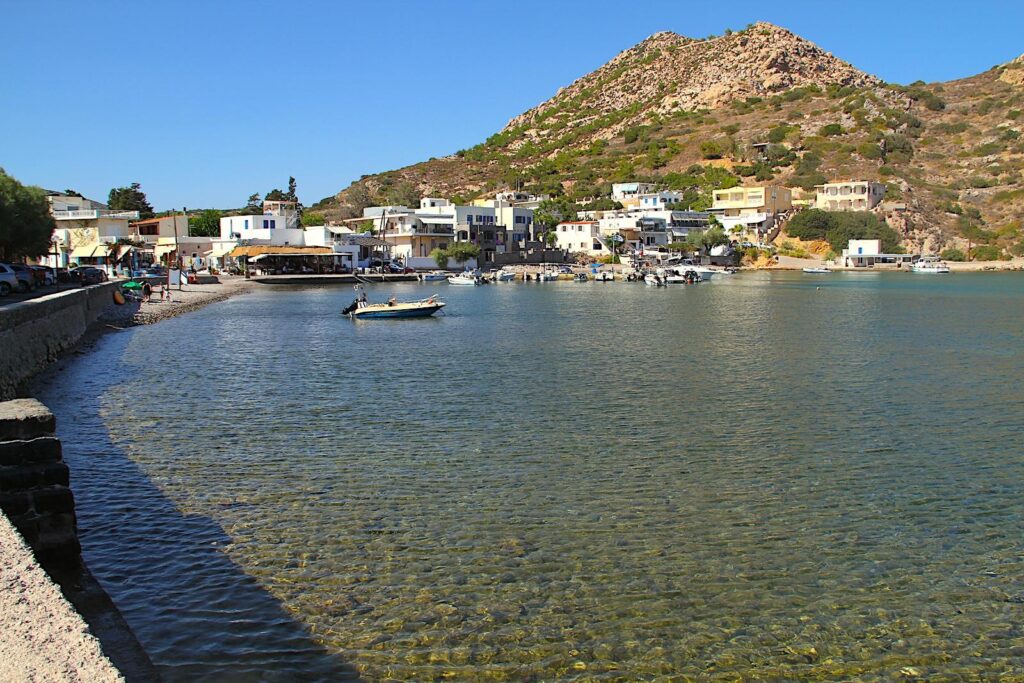
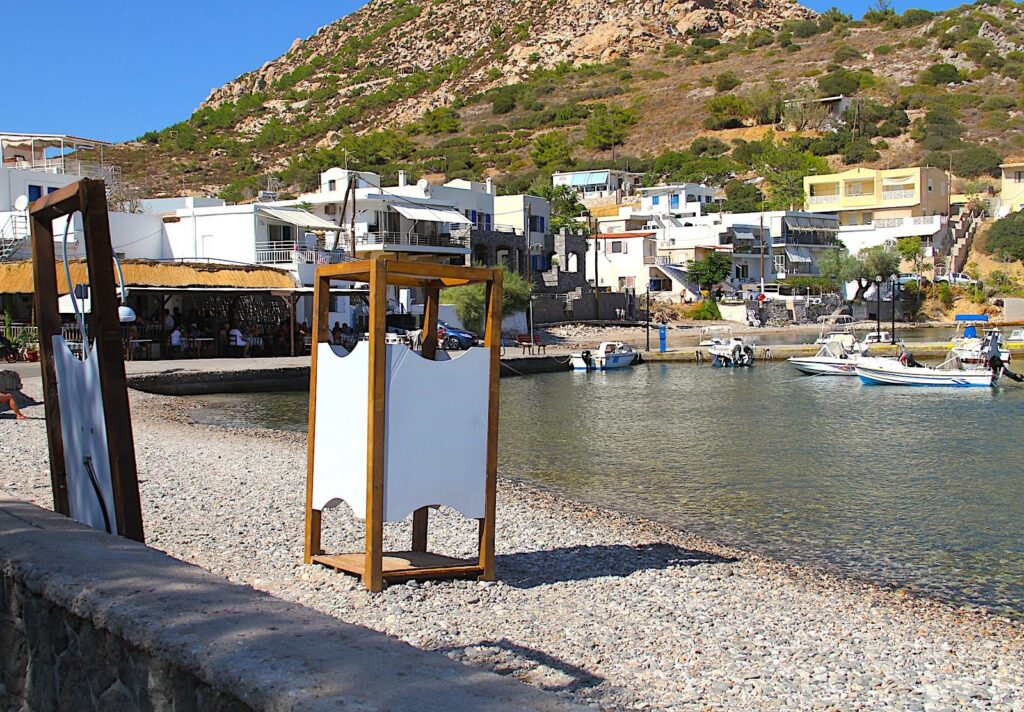
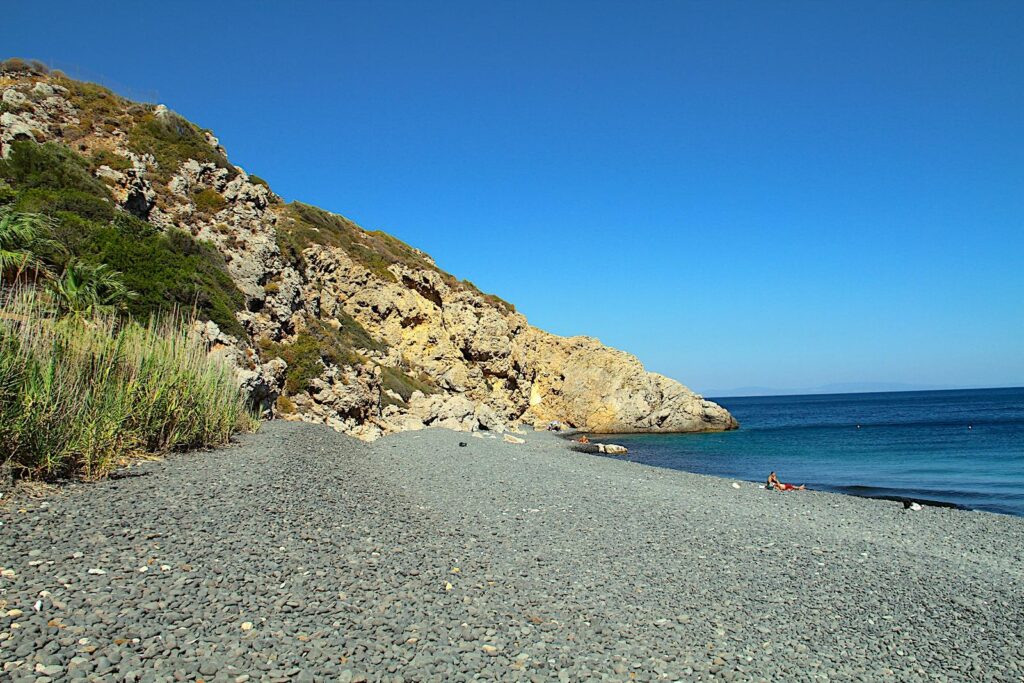
Mavra Volia Beach is a series of three connected bays; the main bay is the largest and most popular, but visitors can also explore the smaller, more secluded bays nearby. The beach is surrounded by rugged cliffs and volcanic rock formations, enhancing its wild and untouched beauty. The lack of major development in the area contributes to a serene and natural environment, making it a perfect spot for those seeking tranquillity and natural beauty. 2km from the beach is the archaeological site of Emporios, which includes ancient ruins dating back to the Neolithic period. The beach is accessible by road, and there is a parking area nearby; there are no organised facilities such as sunbeds or umbrellas, so visitors often bring their supplies. The cliffs and trees provide some natural shaded areas, but it’s advisable to bring sunscreen and other necessities if planning to spend an extended period on the beach.
Agia Dynami Beach – Southern Coast of Chios
Location: Agia Dynami Beach (Παραλία Αγία Δύναμη), Mastichochoria, Chios, 821 02, Greece. 37km southwest of Chios Town.
Agia Dynami Beach is a hidden gem located on the southern coast of Chios, 5km from the medieval village of Olympi, known for its pristine natural beauty, crystal-clear waters, and tranquil atmosphere. The beach is nestled in a remote area, surrounded by rugged hills and natural landscapes, contributing to its untouched charm. The beach is accessible by car on the road leading south past the caves from Olympi and through the mastic groves to the shore. Adjacent to the chapel above the beach is an ample-sized car park. Agia Dynami Beach is characterised by its soft white sand mixed with small pebbles, creating a stunning contrast with the turquoise waters of the Aegean Sea. The beach is relatively narrow, but its beauty more than makes up for its size. The waters at Agia Dynami are exceptionally clear, with shades ranging from light turquoise to deep blue. The undeveloped beach has no facilities such as sunbeds, umbrellas, or cafes. The beach takes its name from the small chapel of Agia Dynami (Saint Dynamis), located nearby, a charming chapel overlooking the beach.
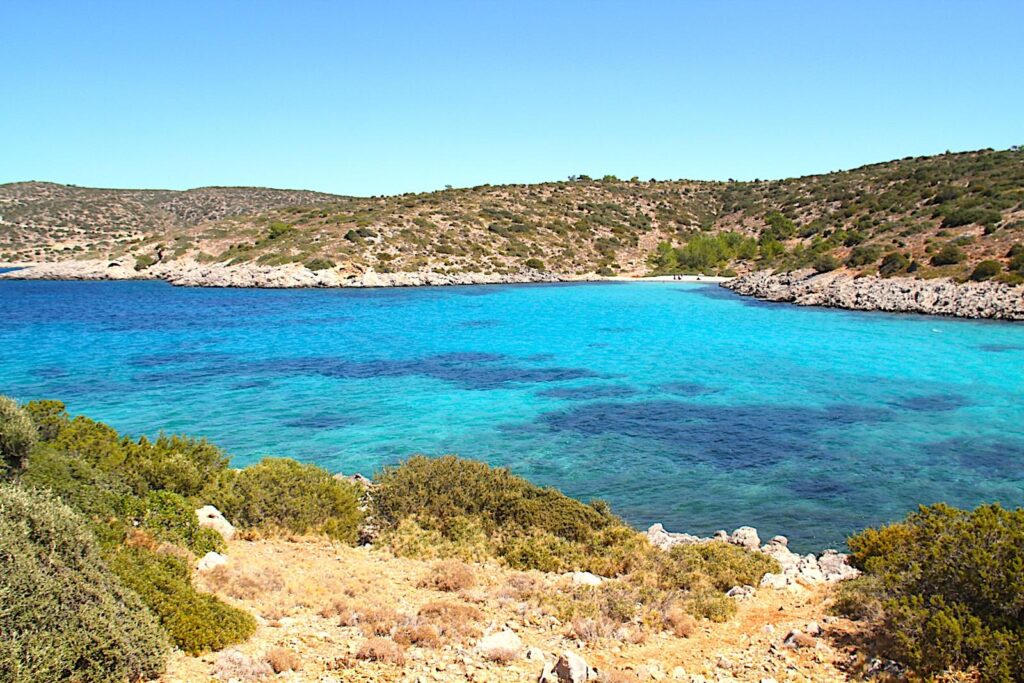
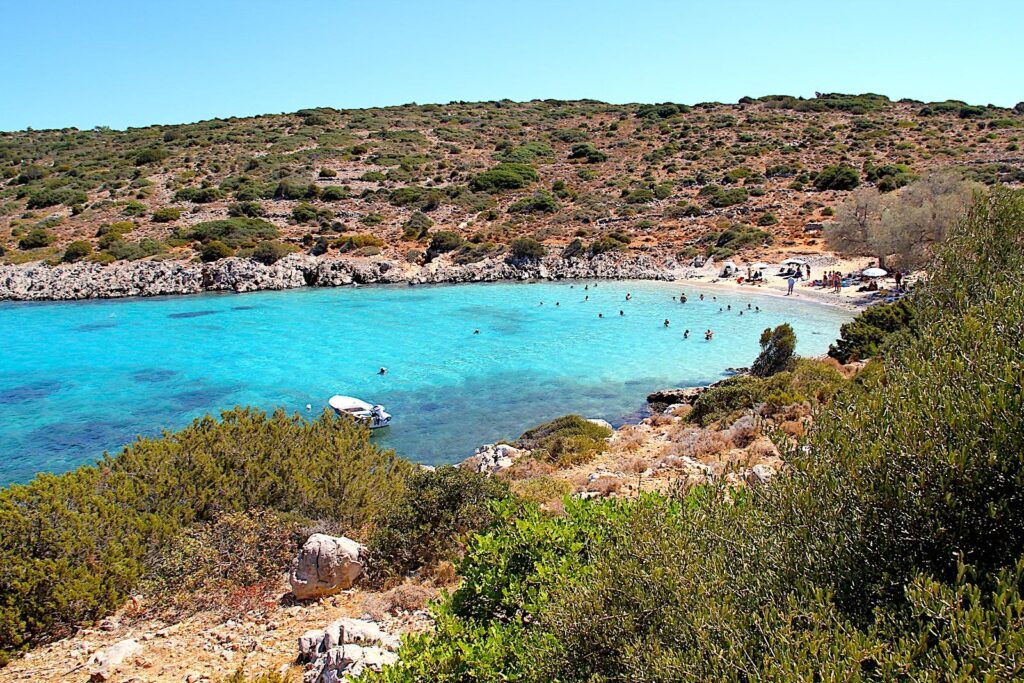

What to Buy in Chios
When visiting Chios, you’ll find various unique products that reflect the island’s rich cultural heritage, local craftsmanship, and natural resources. Here are some top items to buy in Chios: Chios is world-famous for its mastic gum, a resin harvested from the mastic trees in the southern part of the island. The raw mastic gum can be chewed or used in cooking. Mastic liqueur: A sweet, aromatic liqueur, a digestif or for mixing in cocktails. Mastic flavoured sweets: You can find a range of sweets flavoured with mastic, including Turkish delight (loukoumi), and mastic-flavoured chocolates. Mastic oil: An essential that’s used in cosmetics, perfumes, and as an essence in gourmet foods.

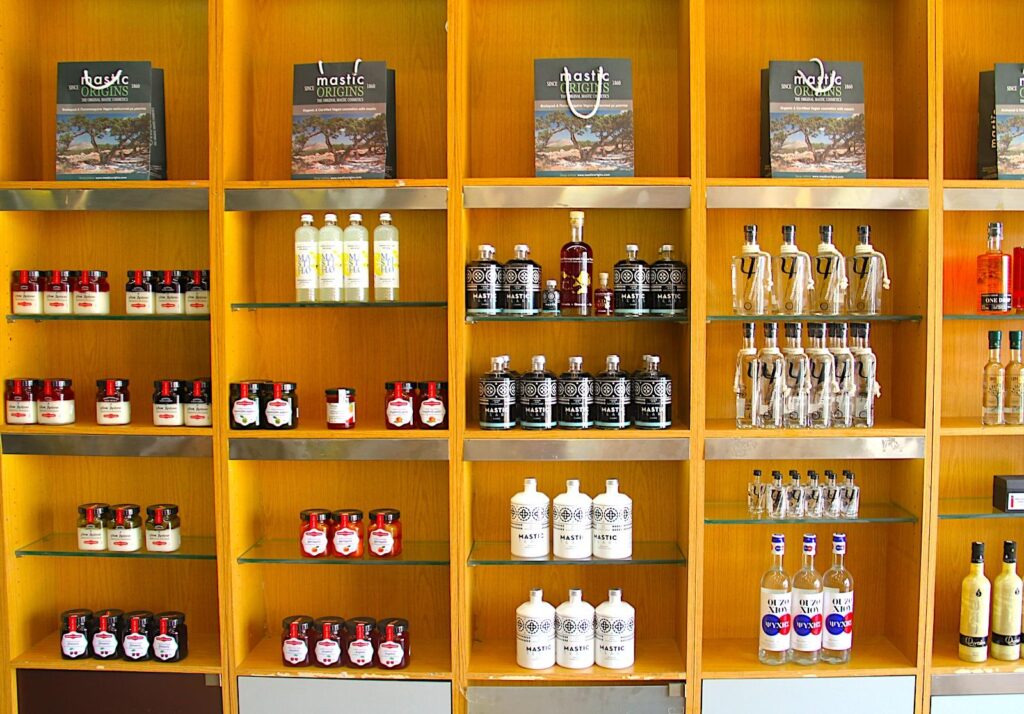
Local Wines such as Ariousios wine: A historic wine revived in Chios, available in red, white, and rosé varieties. This wine is made from local grape varieties and carries the island’s rich wine-making tradition. Some wineries produce unique wines infused with mastic, offering a distinctive mastic wine flavour profile that you won’t find elsewhere. Thyme honey: Chios is known for its high-quality thyme honey, which has a robust flavour. Mastic honey: Some beekeepers on the island produce honey flavoured with mastic.
Handmade Textiles and Embroidery, including traditional embroidered linens: The villages of Chios, especially Pyrgi and Mesta, are known for their intricate embroidery work. Beautiful tablecloths, doilies, and other linen products showcase the island’s traditional designs. Handwoven textiles, including rugs, blankets, and throws, are popular items, often made using techniques passed down through generations. Chios has a long tradition of pottery-making, including beautiful ceramic pieces like vases, bowls, and decorative items that often feature traditional patterns and designs. Some artisans create hand-painted tiles that can be used for home decoration or as unique souvenirs.
Chios produces high-quality extra virgin olive oil, and items made from the wood of the island’s olive trees, such as kitchen utensils, cutting boards, and decorative items, are popular purchases. Wild herbs, such as oregano and thyme, are harvested on the island and sold dried. Spoon sweets (Glyka tou Koutaliou) are traditional preserves from local fruits, including citrus, figs, and cherries, and are a sweet treat with coffee or water. Pasteli: A traditional sweet made from sesame seeds and honey, often formed into bars or small pieces and sometimes flavoured with mastic. Chios is famous for its mandarin oranges, and you can find a delightful Mandarin liqueur made from these aromatic fruits, citrus jams, and marmalades.
There are leather goods such as handmade sandals for which Chios has artisans who craft high-quality leather sandals, often in traditional Greek styles. You can also find delightfully made leather bags, belts, and other accessories frequently crafted by local artisans. Other purchases can include Traditional Music Instruments such as the tsambouna a traditional Greek bagpipe, it’s a unique item for music enthusiasts and those interested in traditional Greek culture or a lyra, a string instrument with deep roots in Greek music.
Chios Guided Tours
On GetYourGuide and Tripadvisor, the Island of Chios offers a variety of guided tours that cater to different interests, allowing visitors to explore its rich history, stunning landscapes, and unique culture. One popular option is the Chios Island Highlights Tour, which takes visitors to key attractions such as the medieval villages of Pyrgi and Mesta, known for their distinctive architecture and mastic production. These tours often include visits to the Nea Moni Monastery, the UNESCO World Heritage Site, and the Cave of Olympi, offering insights into the island’s Byzantine history and natural wonders. Additionally, guided boat tours are available, showcasing the island’s pristine beaches, hidden coves, and the nearby island of Inousses, often with opportunities for swimming and snorkeling in the crystal-clear waters of the Aegean Sea.
For those interested in culinary and cultural experiences, food and wine tours are a highlight, where visitors can sample local specialties like mastic products, olive oil, and traditional Greek dishes. Some tours also focus on the island’s mastic-growing villages, providing a deeper understanding of this unique agricultural tradition. Walking tours in Chios Town (Chora) are another option, exploring its historic harbor, Ottoman-era mosques, and vibrant markets. Both platforms also offer private tours for a more personalized experience, as well as day trips from neighboring islands like Lesvos or Samos. Whether you’re drawn to history, nature, or gastronomy, Chios’ guided tours provide a well-rounded and immersive way to discover this enchanting Greek island.
